

Understanding the World and Shaping Its Future
Through bold thinking, rigorous scholarship, and cross-cutting collaborations, Yale research pushes the boundaries of scientific and technological knowledge to benefit people and our planet.
Conduct scientific research
Search for equipment and services.
Find support
Access resources and information essential to scientific research.
Building blocks for breakthroughs
From A(nalytical and stable isotopes) to Z(ebrafish phenotyping), research at Yale combines serious inquiry, deep expertise, and state-of-the-art technology.
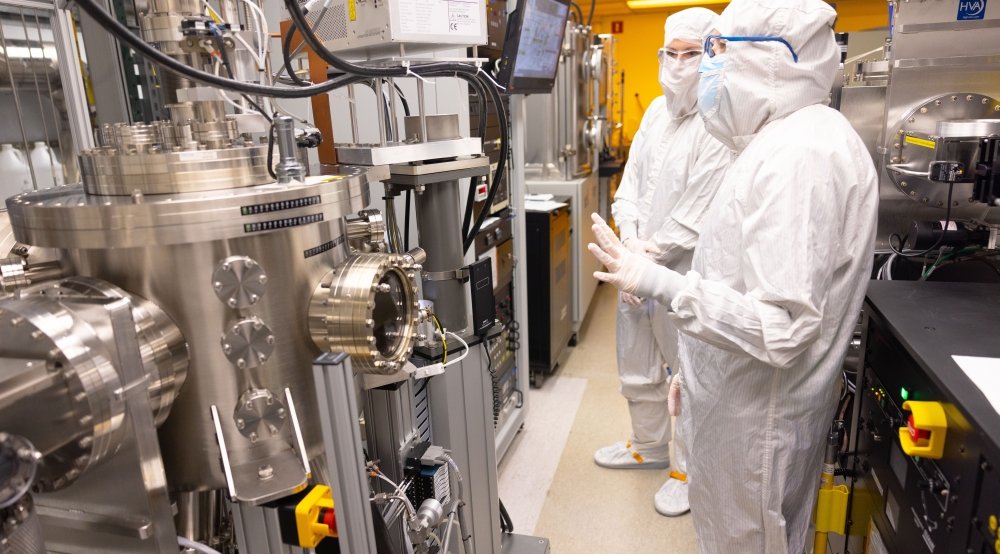
Yale’s research cores enable scientists across campus to interact, collaborate, and develop new applications that advance the university’s scientific mission.
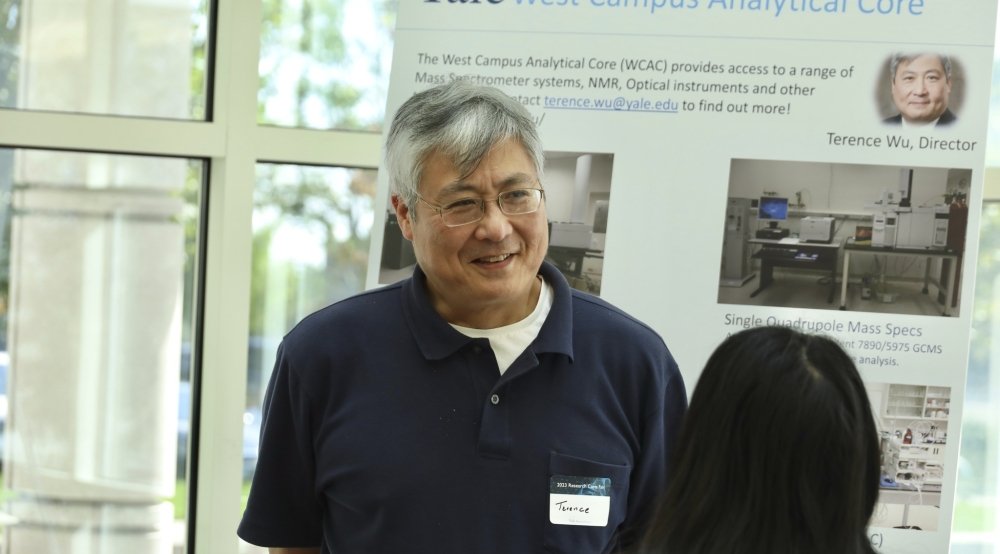
At a series of autumn Cores Fairs, visitors learn how core facilities can help with their research. Mass spectrometry and nuclear magnetic resonance (NMR) spectroscopy are among the offerings at West Campus Analytical Core.
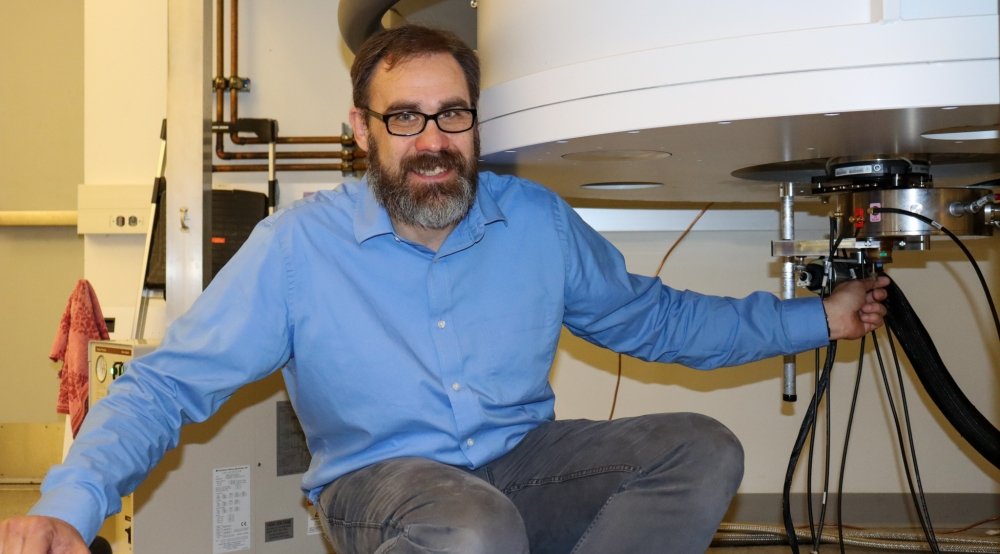
Eric Paulson, PhD, tunes the probe under a nuclear magnetic resonance (NMR) spectrometer, one of twelve at the Chemical and Biophysical Instrumentation Center (CBIC). The Center also houses instruments for mass spectrometry and X-rays.
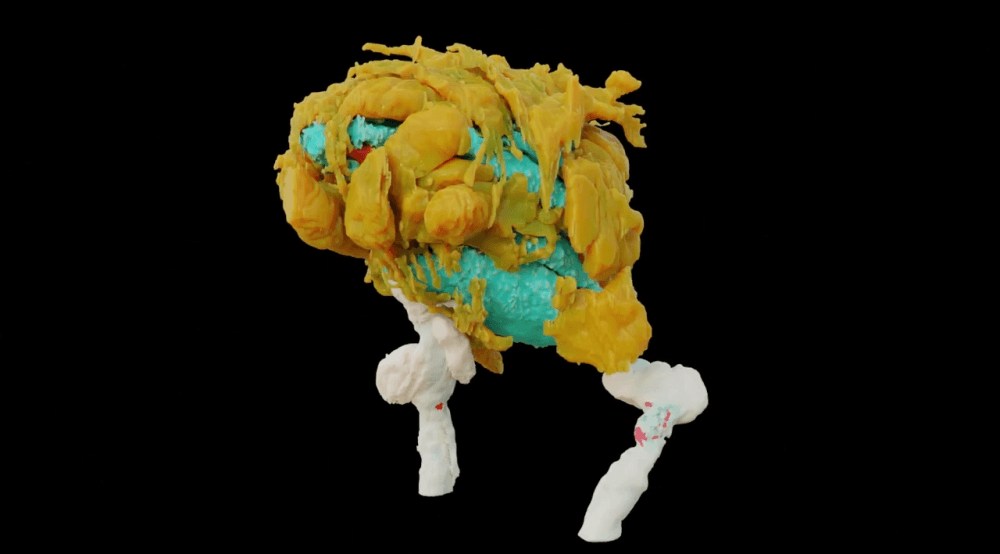
A Meissner corpuscle is a group of cells that acts as a touch detector. Its 3D structure was revealed for the first time using enhanced focused ion-beam scanning electron microscopy (FIB-SEM). Image credit: Yury Nikolaev, PhD, a postdoctoral fellow in the Slav Bagriantsev lab .
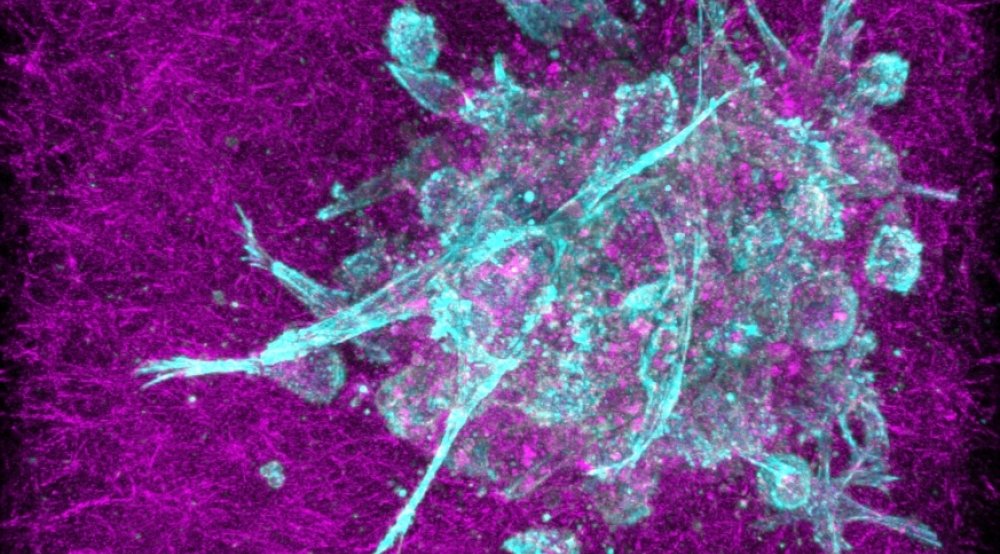
Liver cancer cells escape a tumor spheroid in a fibrotic environment. This Art in Research contest -winning image was collected by Xiangyu Gong, a postdoctoral associate in the Michael Mak biomedical engineering lab , with a Leica SP8 Confocal microscope.
Research cores make science easier, more fruitful, and more efficient.
“You’d be hard-pressed to find a high-profile experimental research paper from Yale that hasn’t been touched by a core."
Related Research Cores
- Yale Institute for Nanoscience and Quantum Engineering (YINQE)
- Yale CryoEM Resource
- Keck Microarray Shared Resource
- Yale Analytical and Stable Isotope Center (YASIC)
- West Campus Imaging Core
Characterizing and elucidating structures
“The WCAC provides our research community here at Yale access to high-level instrumentation, helping to forward discovery.”
- West Campus Analytical Core
A more collaborative approach
"One of the most enjoyable aspects of what we do is collaborate with the grad students and faculty to solve the problems they’re up against. It’s not just cranking out the data."
Cutting-edge electron microscopy
“Potentially, this research will inform the development of tactile sensors for next generation of prosthetics.”
- FIB-SEM Collaboration Core (F-SCC)
New cancer insights
"Compared to cell culture in a petri dish, the three-dimensional models provide new insights into understanding cancer and enable more accurate cancer drug screening. Yale core facilities make it possible for us to unveil novel cellular behaviors in the midst of disease progression."
- Confocal Microscopy at CCMI
By the numbers
Yale takes a data-intensive approach to science and technology research, harnessing today's volume, speed, and availability of data to transform knowledge production.
Research Infrastructure
- 70+ core science facilities
- 1,169 specialized reference databases
- 10 campus libraries
- 15.9 million volumes across Yale's collections
Empowering Support
in sci/tech R&D expenditures in FY22
HERD Report, 2022
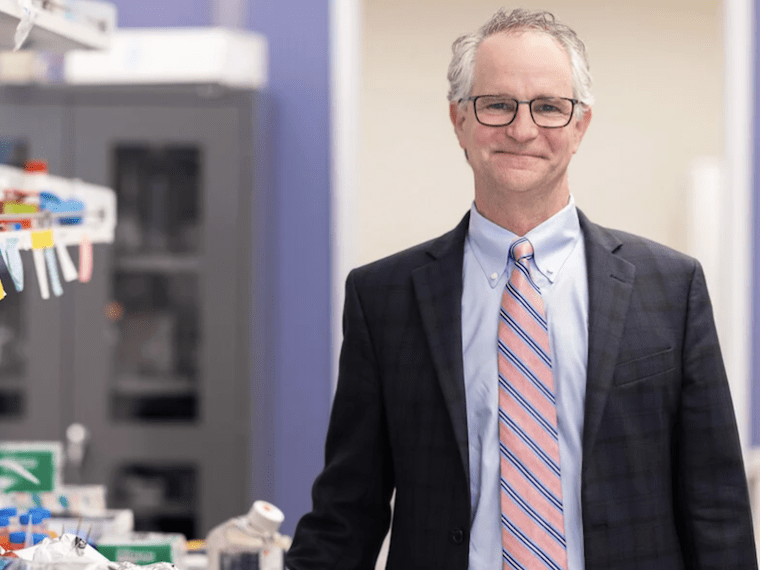
‘Full steam ahead’: Yale research as engine of innovation
In a Q&A, Michael C. Crair, Yale’s vice provost for research, discusses Yale's ongoing research enterprise and the role of federal funding for basic research.
Roberts Innovation Fund to support inventions in AI, quantum, water
The awards provide $1 million in accelerator funding to support 10 new inventions led by faculty from Yale’s School of Engineering & Applied Science.
Opinion: Connecticut must seize quantum technology opportunity and the job crea…
As QuantumCT works to position Connecticut as a quantum tech leader, we urge Congress to fully fund the CHIPS and Science Act—and we invite Connecticut residents, lawmakers, businesses, and organizations to join in the work.
World’s most powerful 3D super-resolution microscope arrives at Yale’s West Ca…
Yale researchers will soon watch individual molecules move through living cells, thanks to the arrival of an Abberior MINFLUX instrument, the world’s most powerful 3D super-resolution fluorescence microscope.
Announcements
Salaries for research scientists & postdocs in fas, seas, yse; 2024-2025.
New 12-month salary minima are effective July 1, 2024.
Yale Center for Geospatial Solutions has its first executive director
Jennifer Marlon will begin her appointment on July 1, 2024.
Tech Tank to open at West Campus
Celebrate the new facility's grand opening May 9th with tours, robotics demonstrations, and more.
University of Michigan
- Academic Calendar
- Email — UMHS
- Library Catalog
- Maps & Directions
- Schools & Colleges
- Wolverine Access
- Prospective Students
- Current Students
- Faculty & Staff
- Life at Michigan
- Health & Medicine
- Initiatives
With expenditures in excess of $1 billion, research is central to U-M’s mission and permeates all 19 schools and colleges. U-M is a strong advocate of promoting collaboration and interdisciplinary research initiatives that involve faculty and students from across campus.

U-M researchers have demonstrated organic solar cells that can achieve 8 percent efficiency.
Research Attention
Below are 25 research outputs that have received attention in the news, social media and other digital sources in the past week ranging from “mainstream” sources to citations. This work from University of Michigan researchers represents a tiny fraction of the more than 263,000 research outputs produced by our academic community.
Resistance Exercise Training in Individuals With and Without Cardiovascular Disease: 2023 Update: A Scientific Statement From the American Heart Association
- Article in Circulation
- December 2023
- 269 mentions in the past week
European Society of Endocrinology and Endocrine Society Joint Clinical Guideline: Diagnosis and therapy of glucocorticoid-induced adrenal insufficiency
- Article in European Journal of Endocrinology
- 134 mentions in the past week
Dementia prevention, intervention, and care: 2024 report of the Lancet standing Commission
- Article in The Lancet
- 97 mentions in the past week
Spatial and temporal patterns of mass bleaching of corals in the Anthropocene
- Article in Science
- January 2018
- 96 mentions in the past week
What Is Dengue?
- Article in JAMA: Journal of the American Medical Association
- August 2024
- 75 mentions in the past week
Earth's Sea Ice Radiative Effect From 1980 to 2023
- Article in Geophysical Research Letters
- 50 mentions in the past week
Evaluation and management of hypertensive emergency
- Article in British Medical Journal
- 42 mentions in the past week
A Systematic Overview of Single-Cell Transcriptomics Databases, their Use cases, and Limitations.
- 35 mentions in the past week
Longitudinal associations of e-cigarette use with cigarette, marijuana, and other drug use initiation among US adolescents and young adults: Findings from the Population Assessment of Tobacco and Health study (Waves 1-6)
- Article in Drug & Alcohol Dependence
- 31 mentions in the past week
Genetics and Genomics of Pulmonary Fibrosis: Charting the Molecular Landscape and Shaping Precision Medicine.
- Article in American Journal of Respiratory & Critical Care Medicine
- 27 mentions in the past week
Globally resolved surface temperatures since the Last Glacial Maximum
- Article in Nature
- November 2021
- 23 mentions in the past week
Baseline characteristics of patients with heart failure with mildly reduced or preserved ejection fraction: The FINEARTS‐HF trial
- Article in European Journal of Heart Failure
Mineralocorticoid Receptor Antagonism Prevents Aortic Plaque Progression and Reduces Left Ventricular Mass and Fibrosis in Patients With Type 2 Diabetes and Chronic Kidney Disease: The MAGMA Trial.
- 22 mentions in the past week
From fibrositis to fibromyalgia to nociplastic pain: how rheumatology helped get us here and where do we go from here?
- Article in Annals of the Rheumatic Diseases
- 21 mentions in the past week
Adjuvant Trastuzumab Emtansine Versus Paclitaxel Plus Trastuzumab for Stage I Human Epidermal Growth Factor Receptor 2-Positive Breast Cancer: 5-Year Results and Correlative Analyses From ATEMPT.
- Article in Journal of Clinical Oncology
- 19 mentions in the past week
Estimated Exposure to 6 Potentially Hepatotoxic Botanicals in US Adults
- Article in JAMA Network Open
- 18 mentions in the past week
Mobilizing Sexism: The Interaction of Emotion and Gender Attitudes in the 2016 US Presidential Election
- Article in Public Opinion Quarterly
Longitudinal Interplay Between Alcohol Use, Mood, and Functioning in Bipolar Spectrum Disorders
Zfp697 is an rna-binding protein that regulates skeletal muscle inflammation and remodeling..
- Article in Proceedings of the National Academy of Sciences of the United States of America
Manufacturing a chimpanzee adenovirus‐vectored SARS‐CoV‐2 vaccine to meet global needs
- Article in Biotechnology & Bioengineering
- 17 mentions in the past week
Development of a Definition of Postacute Sequelae of SARS-CoV-2 Infection
- 16 mentions in the past week
Targeting the central melanocortin system for the treatment of metabolic disorders
- Article in Nature Reviews Endocrinology
A systematic review and meta‐analysis of herpes zoster occurrence/recurrence after COVID‐19 infection and vaccination
- Article in Journal of Medical Virology
- 15 mentions in the past week
The human CD47 checkpoint is targeted by an immunosuppressive Aedes aegypti salivary factor to enhance arboviral skin infectivity
- Article in Science Immunology
Epistemic Exclusion: A Theory for Understanding Racism in Faculty Research Evaluations
- Article in American Psychologist
An ecology and evolutionary biology student works on a collection project of aquatic life at the Dana Building.
- © 2024 The Regents of the University of Michigan 500 S. State Street, Ann Arbor, MI 48109 USA
- Privacy Notice
- Phone +1 (734) 764-1817
- Portal en Español
- खबरें हिंदी में
- X (twitter)
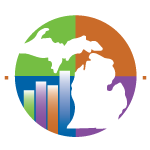
Important Addresses

Harvard College
University Hall Cambridge, MA 02138
Harvard College Admissions Office and Griffin Financial Aid Office
86 Brattle Street Cambridge, MA 02138
Social Links
If you are located in the European Union, Iceland, Liechtenstein or Norway (the “European Economic Area”), please click here for additional information about ways that certain Harvard University Schools, Centers, units and controlled entities, including this one, may collect, use, and share information about you.
- Application Tips
- Navigating Campus
- Preparing for College
- How to Complete the FAFSA
- What to Expect After You Apply
- View All Guides
- Parents & Families
- School Counselors
- Información en Español
- Undergraduate Viewbook
- View All Resources
Search and Useful Links
Search the site, search suggestions.
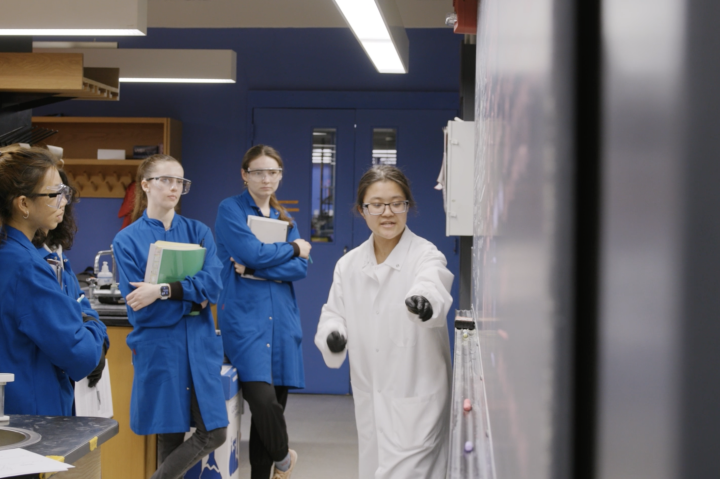
students in a lab with a professor. they are all wearing lab coats
Unlock Your World
From laboratory study to archival research to investigations in the field, Harvard students engage in world-class research across all disciplines and make groundbreaking contributions to their fields.
With support from a variety of funding sources, students collaborate with renowned faculty researchers whose work has been featured in top journals and awarded prestigious grants. Whether you assist your professor or lead your own project, you'll receive guidance, support, and the benefit of their expertise.
Research Opportunities
Are there research opportunities for undergraduates.
Yes - available to students as early as their freshman year. You may find research projects through individual inquiries with departments and professors, through the Harvard College Research Program (HCRP), or through the Mellon Mays Undergraduate Fellowship Program (MMUF). The Faculty Aide Program , run by the Student Employment Office, links professors to undergraduates interested in becoming research assistants. Read more about HCRP and MMUF on the Office of Undergraduate Research and Fellowships website , and find additional opportunities on the Student Employment Office website .

Expanding Our Campus
The state-of-the-art Science and Engineering Complex expands Harvard's campus with an additional 500,000 square feet of classrooms, active learning labs, maker space, and common areas.
Term-Time Research
During the academic year, you can conduct research for credit, as determined by the director of undergraduate study in each department.
Students can also receive funding from one of many sources. Additionally, many faculty members across academic departments hire students directly to serve as research assistants.
funding sources
Harvard college research program.
The Harvard College Research Program (HCRP) provides term-time and summer grants for students conducting independent research in collaboration with a faculty mentor.
Faculty Aide Program
The Faculty Aide Program (FAP) provides half of a student’s total wages when working for an approved faculty member as a research assistant.
Mellon Mays Undergraduate Fellowship Program
The Mellon Mays Undergraduate Fellowship Program (MMUF) provides a term-time stipend, as well as the option for summer research funds, to a group of approximately 20 juniors and seniors, selected in the spring of their sophomore years.
Laboratories

Summer Research
Harvard offers many residential research programs for students staying on campus during the summer. In addition, funding is available to support independent research locally, domestically, and internationally.
Building Learning through Inquiry in the Social Sciences
Building Learning through Inquiry in the Social Sciences (BLISS) is a 10-week program for students working with Harvard faculty on research projects in the social sciences. BLISS provides a stimulating, collegial, and diverse residential community in which students conduct substantive summer research.
Harvard College-Mindich Program in Community-Engaged Research
The Harvard College-Mindich Program in Community-Engaged Research (PCER) introduces students to the field of engaged scholarship, which seeks to advance the public purpose of higher education through scholarship that has impact within and beyond the academy.
Program for Research in Markets and Organizations
The Program for Research in Markets and Organizations (PRIMO) is a 10-week summer program that allows students to work closely with Harvard Business School faculty on projects covering topics from business strategy to social media, and from innovation management to private equity.
Program for Research in Science and Engineering
The Program for Research in Science and Engineering (PRISE) is a 10-week summer program that aims to build community and stimulate creativity among Harvard undergraduate researchers in the life, physical/natural, engineering, and applied sciences.
Summer Humanities and Arts Research Program
The Summer Humanities and Arts Research Program (SHARP) is a 10-week summer immersion experience in which students engage in substantive humanities- and arts-based research designed by Harvard faculty and museum and library staff.
Summer Undergraduate Research in Global Health Program
The Summer Undergraduate Research in Global Health Program (SURGH) is a 10-week summer program in which students research critical issues in global health under the direction of a Harvard faculty or affiliate mentor. Participants live in a diverse residential community of researchers, attend weekly multidisciplinary seminars with professionals in the global health field, and make connections beyond the traditional health sphere.
Summer Program for Undergraduates in Data Science
The Summer Program for Undergraduates in Data Science (SPUDS) is a 10-week summer data science research experience that encourages community, creativity, and scholarship through applications across the arts, humanities, sciences and more fields. Students interested in mathematics, statistics, and computer science collaborate on projects with a Harvard faculty host.
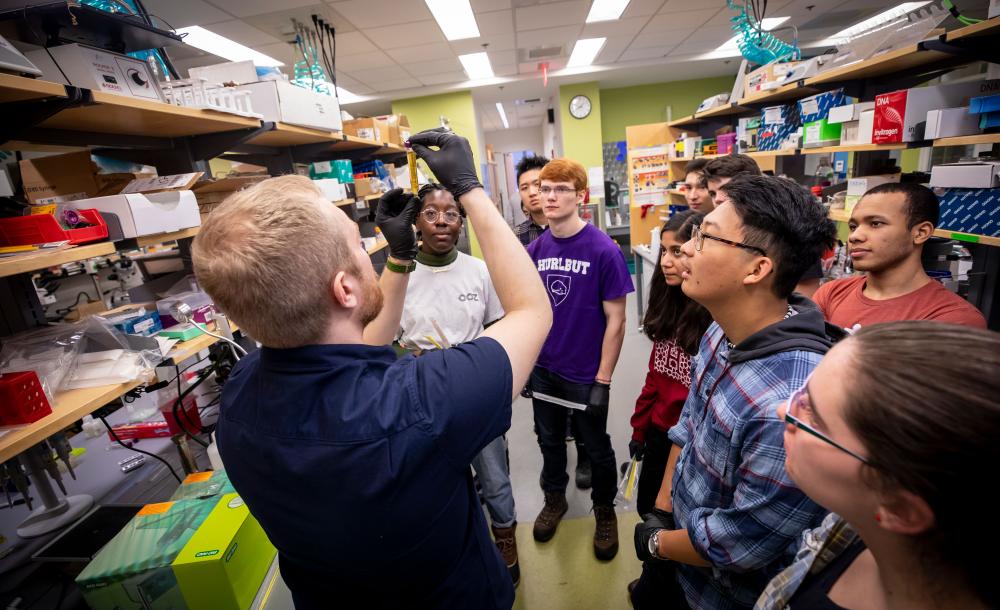
Voyage of Discovery
The Office of Undergraduate Research and Fellowships helps students navigate the research opportunities available here on campus, in the Cambridge area, and around the world.
Related Topics
College offices.
Harvard College offices provide support and help students to navigate everything from academics to student billing.
From physical spaces to funding, Harvard provides the support for students to follow their curiosity as they investigate and explore their world.
Academic Environment
Explore what makes Harvard such a unique place to live and learn.
Toggle Academics Submenu
You are using an outdated browser. Please upgrade your browser to improve your experience.
- Undergraduate Research
You are in a modal window. Press the escape key to exit.
- News & Events
- See programs
Common Searches
- Why is it called Johns Hopkins?
- What majors and minors are offered?
- Where can I find information about graduate programs?
- How much is tuition?
- What financial aid packages are available?
- How do I apply?
- How do I get to campus?
- Where can I find job listings?
- Where can I log in to myJHU?
- Where can I log in to SIS?
- University Leadership
- History & Mission
- Diversity & Inclusion
- Notable Alumni
- Hopkins in the Community
- Hopkins in D.C.
- Hopkins Around the World
- News from Johns Hopkins
- Undergraduate Studies
- Graduate Studies
- Online Studies
- Part-Time & Non-Degree Programs
- Summer Programs
- Academic Calendars
- Advanced International Studies
- Applied Physics Laboratory
- Arts & Sciences
- Engineering
- Peabody Conservatory
- Public Health
- Undergraduate Admissions
- Graduate Admissions
- Plan a Visit
- Tuition & Costs
- Financial Aid
- Innovation & Incubation
- Bloomberg Distinguished Professors
- Our Campuses
- About Baltimore
- Housing & Dining
- Arts & Culture
- Health & Wellness
- Disability Services
- Calendar of Events
- Maps & Directions
- Contact the University
- Employment Opportunities
- Give to the University
- For Parents
- For News Media
- Office of the President
- Office of the Provost
- Gilman’s Inaugural Address
- Academic Support
- Study Abroad
- Nobel Prize winners
- Homewood Campus
- Emergency Contact Information
As America’s first research university , we have been tackling difficult questions and finding answers since 1876.
Every day, our faculty and students work side by side in a tireless pursuit of discovery, continuing our founding mission to bring knowledge to the world. Whether you study engineering, chemistry, music, anthropology, or all of the above, every student here—no matter his or her major—is an investigator.
You can find research in whatever field you want because everyone here is doing some sort of research, and you can help out.

Explore supernovae alongside a Nobel laureate. Learn how to make music with lasers . Create devices that will save lives in impoverished countries . Take a grand tour of the cities that inspired some of the Western world’s great thinkers—Venice, Florence, Paris, or London.
At Hopkins, you can do all of the above. The possibilities are limited only by your imagination.

Two juniors named Goldwater Scholars
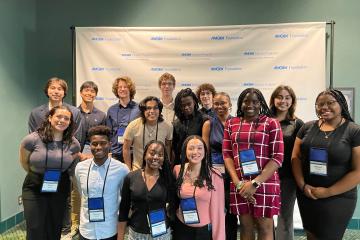
Program funds undergraduate summer research experiences

Rising senior earns Beinecke Scholarship
Programs & fellowships.
- Provost’s Undergraduate Research Awards : Receive up to $3,000 and be paired with a full-time faculty sponsor for research on any topic of your choosing
- Woodrow Wilson Undergraduate Research Fellowship Program : Engage in hands-on, independent learning with faculty mentors and receive funding of up to $10,000 over four years
- ASPIRE grants : Promote independent research projects among undergrads in the School of Arts and Sciences; awards range from $500 to $4,500 per academic year
Learn more:
- Hopkins Office of Undergraduate Research
- Student research opportunities at the School of Engineering
- Student research opportunities at the School of Arts and Sciences

- Johns Hopkins University
- Address Baltimore, Maryland
- Phone number 410-516-8000
- © 2024 Johns Hopkins University. All rights reserved.
- Schools & Divisions
- Admissions & Aid
- Research & Faculty
- Campus Life
- University Policies and Statements
- Privacy Statement
- Title IX Information and Resources
- Higher Education Act Disclosures
- Clery Disclosure
- Accessibility
- Skip to main content
- Skip to primary sidebar
- Skip to footer
- QuestionPro

- Solutions Industries Gaming Automotive Sports and events Education Government Travel & Hospitality Financial Services Healthcare Cannabis Technology Use Case AskWhy Communities Audience Contactless surveys Mobile LivePolls Member Experience GDPR Positive People Science 360 Feedback Surveys
- Resources Blog eBooks Survey Templates Case Studies Training Help center
Home Market Research
What is Research: Definition, Methods, Types & Examples

The search for knowledge is closely linked to the object of study; that is, to the reconstruction of the facts that will provide an explanation to an observed event and that at first sight can be considered as a problem. It is very human to seek answers and satisfy our curiosity. Let’s talk about research.
Content Index
What is Research?
What are the characteristics of research.
- Comparative analysis chart
Qualitative methods
Quantitative methods, 8 tips for conducting accurate research.
Research is the careful consideration of study regarding a particular concern or research problem using scientific methods. According to the American sociologist Earl Robert Babbie, “research is a systematic inquiry to describe, explain, predict, and control the observed phenomenon. It involves inductive and deductive methods.”
Inductive methods analyze an observed event, while deductive methods verify the observed event. Inductive approaches are associated with qualitative research , and deductive methods are more commonly associated with quantitative analysis .
Research is conducted with a purpose to:
- Identify potential and new customers
- Understand existing customers
- Set pragmatic goals
- Develop productive market strategies
- Address business challenges
- Put together a business expansion plan
- Identify new business opportunities
- Good research follows a systematic approach to capture accurate data. Researchers need to practice ethics and a code of conduct while making observations or drawing conclusions.
- The analysis is based on logical reasoning and involves both inductive and deductive methods.
- Real-time data and knowledge is derived from actual observations in natural settings.
- There is an in-depth analysis of all data collected so that there are no anomalies associated with it.
- It creates a path for generating new questions. Existing data helps create more research opportunities.
- It is analytical and uses all the available data so that there is no ambiguity in inference.
- Accuracy is one of the most critical aspects of research. The information must be accurate and correct. For example, laboratories provide a controlled environment to collect data. Accuracy is measured in the instruments used, the calibrations of instruments or tools, and the experiment’s final result.
What is the purpose of research?
There are three main purposes:
- Exploratory: As the name suggests, researchers conduct exploratory studies to explore a group of questions. The answers and analytics may not offer a conclusion to the perceived problem. It is undertaken to handle new problem areas that haven’t been explored before. This exploratory data analysis process lays the foundation for more conclusive data collection and analysis.
LEARN ABOUT: Descriptive Analysis
- Descriptive: It focuses on expanding knowledge on current issues through a process of data collection. Descriptive research describe the behavior of a sample population. Only one variable is required to conduct the study. The three primary purposes of descriptive studies are describing, explaining, and validating the findings. For example, a study conducted to know if top-level management leaders in the 21st century possess the moral right to receive a considerable sum of money from the company profit.
LEARN ABOUT: Best Data Collection Tools
- Explanatory: Causal research or explanatory research is conducted to understand the impact of specific changes in existing standard procedures. Running experiments is the most popular form. For example, a study that is conducted to understand the effect of rebranding on customer loyalty.
Here is a comparative analysis chart for a better understanding:
| Approach used | Unstructured | Structured | Highly structured |
| Conducted through | Asking questions | Asking questions | By using hypotheses. |
| Time | Early stages of decision making | Later stages of decision making | Later stages of decision making |
It begins by asking the right questions and choosing an appropriate method to investigate the problem. After collecting answers to your questions, you can analyze the findings or observations to draw reasonable conclusions.
When it comes to customers and market studies, the more thorough your questions, the better the analysis. You get essential insights into brand perception and product needs by thoroughly collecting customer data through surveys and questionnaires . You can use this data to make smart decisions about your marketing strategies to position your business effectively.
To make sense of your study and get insights faster, it helps to use a research repository as a single source of truth in your organization and manage your research data in one centralized data repository .
Types of research methods and Examples

Research methods are broadly classified as Qualitative and Quantitative .
Both methods have distinctive properties and data collection methods .
Qualitative research is a method that collects data using conversational methods, usually open-ended questions . The responses collected are essentially non-numerical. This method helps a researcher understand what participants think and why they think in a particular way.
Types of qualitative methods include:
- One-to-one Interview
- Focus Groups
- Ethnographic studies
- Text Analysis
Quantitative methods deal with numbers and measurable forms . It uses a systematic way of investigating events or data. It answers questions to justify relationships with measurable variables to either explain, predict, or control a phenomenon.
Types of quantitative methods include:
- Survey research
- Descriptive research
- Correlational research
LEARN MORE: Descriptive Research vs Correlational Research
Remember, it is only valuable and useful when it is valid, accurate, and reliable. Incorrect results can lead to customer churn and a decrease in sales.
It is essential to ensure that your data is:
- Valid – founded, logical, rigorous, and impartial.
- Accurate – free of errors and including required details.
- Reliable – other people who investigate in the same way can produce similar results.
- Timely – current and collected within an appropriate time frame.
- Complete – includes all the data you need to support your business decisions.
Gather insights

- Identify the main trends and issues, opportunities, and problems you observe. Write a sentence describing each one.
- Keep track of the frequency with which each of the main findings appears.
- Make a list of your findings from the most common to the least common.
- Evaluate a list of the strengths, weaknesses, opportunities, and threats identified in a SWOT analysis .
- Prepare conclusions and recommendations about your study.
- Act on your strategies
- Look for gaps in the information, and consider doing additional inquiry if necessary
- Plan to review the results and consider efficient methods to analyze and interpret results.
Review your goals before making any conclusions about your study. Remember how the process you have completed and the data you have gathered help answer your questions. Ask yourself if what your analysis revealed facilitates the identification of your conclusions and recommendations.
LEARN MORE ABOUT OUR SOFTWARE FREE TRIAL
MORE LIKE THIS

Customer Experience Lessons from 13,000 Feet — Tuesday CX Thoughts
Aug 20, 2024

Insight: Definition & meaning, types and examples
Aug 19, 2024

Employee Loyalty: Strategies for Long-Term Business Success

Jotform vs SurveyMonkey: Which Is Best in 2024
Aug 15, 2024
Other categories
- Academic Research
- Artificial Intelligence
- Assessments
- Brand Awareness
- Case Studies
- Communities
- Consumer Insights
- Customer effort score
- Customer Engagement
- Customer Experience
- Customer Loyalty
- Customer Research
- Customer Satisfaction
- Employee Benefits
- Employee Engagement
- Employee Retention
- Friday Five
- General Data Protection Regulation
- Insights Hub
- Life@QuestionPro
- Market Research
- Mobile diaries
- Mobile Surveys
- New Features
- Online Communities
- Question Types
- Questionnaire
- QuestionPro Products
- Release Notes
- Research Tools and Apps
- Revenue at Risk
- Survey Templates
- Training Tips
- Tuesday CX Thoughts (TCXT)
- Uncategorized
- What’s Coming Up
- Workforce Intelligence
Suggestions or feedback?
At MIT, pushing the boundaries of knowledge and possibility is our joyful obsession, and we celebrate fundamental discoveries and practical applications alike. As educators, we also value research as a potent form of learning by doing .
Research flourishes in our 30 departments across five schools and one college , as well as in dozens of centers, labs, and programs that convene experts across disciplines to explore new intellectual frontiers and solve important societal problems. Our on-campus research capabilities are enhanced through the work of MIT Lincoln Laboratory , the Woods Hole Oceanographic Institution , active research relationships with industry , and a wide range of global collaborations .
Centers, Labs & Programs
MIT continually develops organizations and partnerships that foster interdisciplinary work. Listed here are just some of the MIT labs, centers, and programs where groundbreaking research is happening every day.
View Centers, Labs & Programs
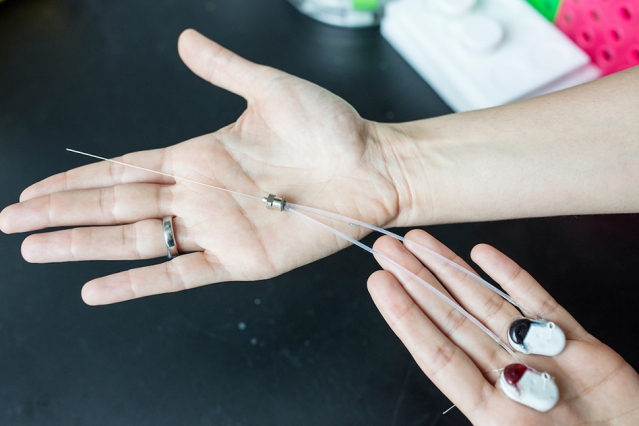
Collaborating Institutions
MIT researchers collaborate with many leading local, national, and international organizations to further drive exploration.
View Collaborating Institutions
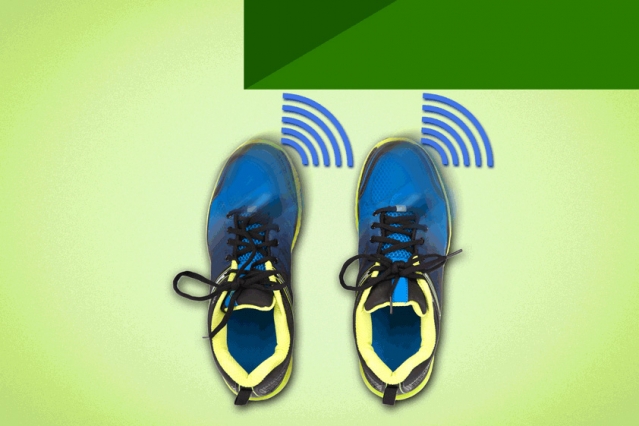
Featured Story Slideshow
Certificate of confidentiality update.
The NEW NIH Certificate of Confidentiality (CoC) policy broadens the definition of identifiable human subjects data, applies to all active NIH funded research, and has specific requirements for when identifiable data can be shared.
Does my research qualify?
Delayed Revision of Human Subjects Regulations
Federal agencies have delayed implementation of the revised human subjects regulations (the “Common Rule”) until July 19, 2018. Questions? Contact the Human Subjects Division at [email protected]
NIH Changes: January 2018
- FORMS-E Application Package with New Human Subjects / Clinical Trial Form
- Broader NIH definition of Clinical Trials
- Clinical Trial Specific Funding Opportunity Announcements
- Single Institutional Review Board (sIRB)
Research Annual Report FY17 Highlights
- $1,628,491,114 in sponsored grants and contracts
- $1,033,812,778 federal funding
- $594,678,336 non-federal funding
- 5,174 awards
- Stats and Rankings
MyResearch Training Transcript
Need to confirm that you have completed a required training, or whether or not it has expired? Visit MyResearch Training Transcript – your resource for institutional research-required training records.
View transcript
Research Annual Report FY18 Highlights
- $1,350,758,513 in sponsored grants and contracts
- $1,035,012,267 federal funding
- $315,746,246 non-federal funding
- 5,367 grants;186 grants over $1m
View FY18 Annual Report
SAGE Budget Sync
Sync your SAGE Budget to Grant Runner RR Detailed Budget
Federal Government Shutdown
We will continue to share guidance and resources from Affected Agencies as we receive them. Learn More
The Revised Common Rule
The human subjects regulations that govern most UW human subjects research have been revised as of January 21, 2019. See HSD’s Revised Common Rule webpage for details and resources.
Revised Common Rule
New Video Resource
Learn about MyResearch in a new 4-minute introduction to the portal.
Welcome to MyResearch
Governor Signs Bill Reducing Burden of Higher Ed Records Research
Governor Inslee signed bill SB 5786 that removes redundant state requirements about human subjects records research already protected by federal regulations. This reduces significant burden to research teams! HSD Director Karen Moe has worked for years in support of this bill, which takes effect on July 28, 2019. Congrats Karen!
Time to renew your Faculty Grants Management Training?
The newly redesigned online refresher highlights recent changes in research administration and policy. View your completed record in MyResearch Training Transcript.
Visit FGM Information
Guidance for Foreign Interests in Sponsored Programs
Our newly published webpage, “Foreign Interests in Sponsored Programs” provides guidance and resources from our federal sponsors on this important and timely issue. We will be posting new information as it becomes available.
Visit Foreign Influence on Sponsored Programs
Search is Here!
The MyResearch Search Alpha feature has been released. Search across the MyResearch portal for applications, awards, non-award agreements and training transcripts.
New! Certificate in Research Administration
We enthusiastically announce the launch of the new Certificate in Research Administration! This certificate provides coursework on research administration practices, policies and procedures, and supports UW learners in forging career pathways. Learn More
Shared Research Facilities and Resources
The Shared Research Facilities and Resources webpage offers an index of resources that include essential services, advanced instrumentation, and technical expertise needed for cutting-edge research. Do you have equipment, facilities or research that are available to the UW community? Contact Us!
Mitigating Impacts to Research Activities Due to COVID-19
-Research operations should continue, see guidance -Some human subjects research has been temporarily halted (see HSD COVID-19 page) -OSP & HSD standing by to facilitate SARS-CoV-2 & COVID-19 proposals Visit Page
THANK YOU RESEARCH COMMUNITY
The Office of Sponsored Programs recorded a heartfelt thank you for our research community.
Watch the Video
Redesigned SAGE Budget
The newly redesigned SAGE Budget is here! Create and manage your budgets using a more streamlined, efficient, and intuitive design.
View Design Highlights
Research Guidance During COVID-19
Research is a CORE function of the UW. Keep up-to-date on research guidance and resources during Phase 2 of the Governor’s “Return to Work” plan.
Mitigating Impacts to Research Due to COVID-19 Guidance for Returning to In-Person Research
October is National Biosafety Month
National Biosafety Month is a perfect time to refocus your attention on all biosafety policies, practices and procedures. Investigators and lab managers should raise biosafety awareness, and discuss the importance of safety. The focus of EH&S is to promote a culture of safety! Read More
October is Cybersecurity Awareness Month
Develop or expand your cyber awareness toolkit with information and training from the Office of the Chief Information Security Officer.
Cybersecurity Awareness
New to UW Research? Welcome!
Whether you are starting out in your first position as a primary investigator, an experienced investigator new to the UW, or research administrator, our New to UW Research webpage will help you find the resources you need.
New Zipline Resources & Improvements for Human Subjects Research
More Zipline help text; short instructional videos ; improvements & additions to the Researcher Guide How to request department administrator access to the department’s IRB applications
The Strength of the UW Research Enterprise in FY2020
- $1,631,239,212 in sponsored grants and contracts (up ~3.3%)
- $1,231,532,044 federal funding (up~.62%)
- $399,707,168 non-federal funding (up ~12.6%)
- 5,506 Awards (up .22%)
New! Foreign Influence and Sponsored Research Video & FAQs
New Foreign Influence and Sponsored Research Video and FAQs provide guidance for researchers engaged in international research collaborations. Watch and review Q&A from subject matter experts.
Watch Video Review the FAQs
SAGE Advance Budget Requests
The new SAGE Advance Budget Request process is now available! The new process includes automated eligibility checks, online approvals for campus, and a new, more intuitive design.
View More Details
HSD - Revisions to Restrictions
COVID-related restrictions on human subjects research are significantly revised.
Read the Webpage
Mari Ostendorf, new UW Vice Provost for Research
On September 1, 2021, Mari Ostendorf was named the UW’s fourth Vice Provost for Research
September 25th is Research Administrator Day!
Honoring our Research Administrators who manage the complexities and sheer workload that support $1.89B in sponsored grants and contracts for FY21. We applaud each and every one!
UW Research Timeline
Explore the vast history of the UW from 1852-to 2021. View groundbreaking research accomplishments and fascinating historical highlights such as our first faculty, student body, and graduate in 1876, Clara McCarty. View the Timeline
Congratulations to Karen Moe!
Former Human Subjects Division Director Karen Moe has been chosen as a recipient of the David B. Thorud Leadership Award. The winners will be honored from 3:30 to 5:30 p.m. on June 9 at the Meany Hall for the Performing Arts. About the Ceremony
Microsoft Will Retire Internet Explorer 11 on June 15, 2022
If you use IE11 to access research systems (including the Research Website), we highly recommend switching to the latest version of Google Chrome, Microsoft Edge, or Mozilla Firefox for the best experience.
Research Report in the B.I. Portal
Review the Research Administration Data (RAD) report that allows you to view proposals and awards based on a specific principal investigator (PI) or keyword is now available in the B.I. Portal.
Learn More About the Report
Supporting Research During UW Finance Transformation
Learn more about UW Finance Transformation (UWFT), the upcoming changes to research administration systems and processes, and how we will support you on our journey to Workday go-live in July 2023!
UWFT for the Research Community
Featuring Online Training: IRB 101
New to working with the UW IRB? Go through the basics step by step in the IRB 101 online tutorial, required for students and residents and recommended for others new to human subjects research.
IRB 101 Tutorial
Research Highlights FY22
$1.67B in sponsored grants and contracts $1.27B federal funding $400M non-federal funding 5,605 awards
National Biosafety Month is a perfect time to refocus your attention on safer policies, practices and procedures. Investigators and lab managers should consider substituting potential hazards for safer alternatives. Read about safer alternatives to reduce the potential for harm. Read More
NIH Data Management and Sharing Policy
NIH’s new DMS Policy has significant impacts for proposals submitted for due dates on or after January 25, 2023 resources and more information…
We are approaching the summit on our journey to Workday Finance go-live. With the July 6 launch just around the corner, make sure you are prepared. Visit our webpage, UWFT for the Research Community.
Commemorating Juneteenth: A Celebration of Freedom
On June 19, 1865, Union General Granger informed the enslaved African Americans of their freedom and that the Civil War had ended. This is a day that calls for respectful acknowledgment of our past and a reflection on our future. Let us all do our part to create lasting change.
NewProfs@UW: Making Connections to Help Launch your Academic Career
NewProfs@UW is an in-person workshop on September 11, 2023 that welcomes incoming faculty to the UW community and connects them to resources that support research, scholarship and career development.
Learn More & Register
Research Administrator Day September 25
Thanks to our outstanding UW Research Administrators! In a top ranked institution with over $1.8 Billion in research funding, our staff are required to have a high level of knowledge and expertise to keep up with complex requirements and heavy workloads.
Join us in celebration
New IRB Tools for Designing Research Consent
The UW IRB has published new resources to assist researchers with designing a participant-focused consent. These tools include new web guidance, new templates, and example consent forms.
UW consent templates
National Biosafety Month is a perfect time to refocus your attention on safer policies, practices, and procedures. Investigators and lab managers are encouraged to develop written SOPs for procedures involving biohazards.
Value of written procedures
Washington Research Foundation – Ronald S. Howell Distinguished Faculty Fellowship
Faculty selected as the inaugural cohort of the Washington Research Foundation–Ronald S. Howell Distinguished Faculty Fellowship, endowed in honor of WRF’s longtime CEO Ron Howell. Awardees are Gabe Cler, Sam Golden, and Amy Orsborn. Announcement
Tips for Award Setup and Modification Requests in SAGE
Visit our webpage featuring quick tips for completing Award Setup and Modification Requests in SAGE, including comments, budgets, returned items, and helpful resources.
Review Tips
SAGE Award Search Now Available!
You can now search for Award Setup, Modification, and Advance Requests from the SAGE Awards section.
The Seattle Hub for Synthetic Biology
The UW Office of Research congratulates The Allen Institute, the Chan Zuckerberg Initiative, and UW Medicine on the launch of their landmark collaboration, The Seattle Hub for Synthetic Biology.
Task Force Outlines Strategies for Incorporating D•E•I• Approaches in Research
The Office of Research Task Force on Equity in Research has released its report on supporting and growing the UW’s incorporation of diversity, equity and inclusion approaches in research.
Royalty Research Fund Grants Awarded
The Office of Research would like to congratulate the 25 UW researchers selected for the January 2024 Royalty Research Fund grant awards.
See awardee list
Xiaosong Li co-leads International Research Team's Attosecond Discovery
Xiaosong Li, Associate Vice Provost for Research Cyberinfrastructure, is the co-lead of an international research team behind a breakthrough discovery which isolates the movement of electrons by measuring time in attoseconds.
Read the article
UW Computer Science and Chemistry Faculty named Sloan Fellows
The Office of Research congratulates UW faculty members Simon S. Du and Adriana Schulz in Computer Science, and Alexandra Velian in Chemistry, on being awarded early-career fellowships from the Alfred P. Sloan Foundation.
New Resources for Grant Reporting
The Office of Research, the Finance DATAGroup, and UW-IT Reporting & Analytics are thrilled to announce three new Grant Reporting resources for grant management: The Grant Planning and Forecasting Tool, The Post-Award Dashboard, and The Principal Investigator Dashboard.
Two UW Researchers Named AAAS Fellows
The Office of Research congratulates UW faculty members Brandi Cossairt in Chemistry and Andy Stergachis in Pharmacy and Global Health on being named Fellows by the American Association for the Advancement of Science.
Apply for an OR-hosted Discussion on Equity in Research for Excellence
The Office of Research invites UW researchers to apply to organize an OR-hosted meal and discussion of its recent Report on Equity in Research for Excellence.
UW Researchers elected to the National Academy of Sciences
Qiang Fu, Calvin professor of Atmospheric Sciences, and Raymond Huey, professor emeritus of Biology, have been elected to the National Academy of Sciences in recognition of their research achievements.
Emancipation Day: Celebrating Freedom and Equality on Juneteenth
Juneteenth marks the date June 19, 1865, when enslaved Black people in Texas learned of their freedom and the end of the Civil War. The Office of Research commemorates Emancipation Day by acknowledging our shared history and working toward a more equitable future.
See DEI Resources
Explore SAGE Budget resources
Review new job aids for award budgets, join weekly SAGE Office Hours, and refresh your SAGE Budget knowledge.
View Resources
The Office of Research would like to congratulate the 25 UW faculty researchers selected for the June 2024 Royalty Research Fund grant awards.
UW ranked No.7 among Best Global Universities
The University of Washington has tied for No. 7 in the U.S. News & World Report’s Best Global Universities 2024-2025 rankings, and ranks No. 2 in public institutions.
Guidance updates on Foreign interests in sponsored programs
Federal Sponsors and the UW prohibit personnel from participating in Malign Foreign Talent Recruitment Programs (MFTRP).
Read more on MFTRP

Register today for the Biomedical Research Integrity Program (BRI)
BRI training is required every four years for all pre-and post-doctoral researchers supported by NIH training grants. Register today to secure your spot in the September 5th program.
Register for BRI
Diversity in Clinical Trials Draft Supplement and Guidance
HSD released a draft Diversity Plan for Clinical Trials supplement and guidance, available for public comment. Visit the link below for more on accessing the draft, providing comments, and an upcoming town hall meeting.
![[Concept - solving a complex problem. Blue maze and floor with yellow solution path with arrow. Banner size.] [Concept - solving a complex problem. Blue maze and floor with yellow solution path with arrow. Banner size.]](https://www.washington.edu/research/wp-content/uploads/AdobeStock_502554360-1-copy-scaled.jpg)
Need help navigating Workday Finance?
The Office of Research maintains the Workday Finance & Research webpage, which includes information, instructions, and resources to help you navigate the transition to Workday Finance. This one-stop resource is updated with the latest information and links as they are released.
Visit Web Page
World Leaders in Research
The office of research invests in the future, enabling research advances to sustain uw’s reputation as a preeminent public university..
- Honors and Awards
- UW Today Featured Research
Announcements
![[Student researchers at the Molecular and Cellular Biology Lab] [Molecular and Cellular Biology Lab]](https://www.washington.edu/research/wp-content/uploads/2017/04/uw-research-feature-uwtoday.jpg)
UW Today: Featured Research
Exciting research is taking place all over campus. Visit UW Today – Research to see what research is being featured.
Visit UW Today-Research
The UW Research Timeline
A look through UW’s vast history of research accomplishments.
Research Timeline
The Office of Research will create an outstanding climate of support for University of Washington researchers, broadly enabling stellar research advances.
University of Washington Office of Research
Or support offices.
- Human Subjects Division (HSD)
- Office of Animal Welfare (OAW)
- Office of Research (OR)
- Office of Research Information Services (ORIS)
- Office of Sponsored Programs (OSP)
OR Research Units
- Applied Physics Laboratory (APL-UW)
- WA National Primate Research Center (WaNPRC)
Research Partner Offices
- Corporate and Foundation Relations (CFR)
- Enivronmental Health and Safety (EH&S)
- Grant and Contract Accounting (GCA)
- Institute of Translational Health Sciences (ITHS)
- Management Accounting and Analysis (MAA)
- Post Award Fiscal Compliance (PAFC)
Collaboration
- Centers and Institutes
- Collaborative Proposal Development Resources
- Research Fact Sheet
- Research Annual Report
- Office of Research
© 2024 University of Washington | Seattle, WA
- {{link.text}}
We tackle the most challenging problems in Computer Science and related fields.
Being bold and taking risks allows our embedded teams to make discoveries that affect billions of users every day.
Our Publications
In-Datacenter Performance Analysis of a Tensor Processing Unit
Norman P. Jouppi, Cliff Young , Nishant Patil, David Patterson , Gaurav Agrawal, Raminder Bajwa, Sarah Bates, Suresh Bhatia, Nan Boden, Al Borchers, Rick Boyle, Pierre-luc Cantin, Clifford Chao, Chris Clark, Jeremy Coriell, Mike Daley, Matt Dau, Jeffrey Dean , Ben Gelb, Tara Vazir Ghaemmaghami, Rajendra Gottipati, William Gulland, Robert Hagmann, C. Richard Ho, Doug Hogberg, John Hu, Robert Hundt , Dan Hurt, Julian Ibarz , Aaron Jaffey, Alek Jaworski, Alexander Kaplan, Harshit Khaitan, Andy Koch, Naveen Kumar, Steve Lacy, James Laudon , James Law, Diemthu Le, Chris Leary, Zhuyuan Liu, Kyle Lucke, Alan Lundin, Gordon MacKean, Adriana Maggiore, Maire Mahony, Kieran Miller, Rahul Nagarajan, Ravi Narayanaswami, Ray Ni, Kathy Nix, Thomas Norrie, Mark Omernick, Narayana Penukonda, Andy Phelps, Jonathan Ross
ISCA (2017) (to appear)
Guetzli: Perceptually Guided JPEG Encoder
Jyrki Alakuijala , Robert Obryk, Ostap Stoliarchuk, Zoltan Szabadka, Lode Vandevenne, Jan Wassenberg
arXiv (2017)
Google's Neural Machine Translation System: Bridging the Gap between Human and Machine Translation
Yonghui Wu , Mike Schuster , Zhifeng Chen , Quoc V. Le , Mohammad Norouzi , Wolfgang Macherey , Maxim Krikun, Yuan Cao, Qin Gao , Klaus Macherey , Jeff Klingner , Apurva Shah, Melvin Johnson , Xiaobing Liu , Łukasz Kaiser , Stephan Gouws , Yoshikiyo Kato , Taku Kudo, Hideto Kazawa, Keith Stevens , George Kurian, Nishant Patil, Wei Wang, Cliff Young , Jason Smith, Jason Riesa , Alex Rudnick , Oriol Vinyals , Greg Corrado , Macduff Hughes, Jeffrey Dean
CoRR, vol. abs/1609.08144 (2016)
Development and Validation of a Deep Learning Algorithm for Detection of Diabetic Retinopathy in Retinal Fundus Photographs
Varun Gulshan , Lily Peng , Marc Coram, Martin C Stumpe , Derek Wu , Arunachalam Narayanaswamy , Subhashini Venugopalan, Kasumi Widner , Tom Madams , Jorge Cuadros, Ramasamy Kim, Rajiv Raman, Philip Q Nelson , Jessica Mega, Dale Webster
JAMA (2016)
Digitized Adiabatic Quantum Computing with a Superconducting Circuit
Rami Barends , Alireza Shabani , Lucas Lamata, Julian Kelly , Antonio Mezzacapo, Urtzi Las Heras, Ryan Babbush , Austin Fowler , Brooks Campbell, Yu Chen, Zijun Chen, Ben Chiaro, Andrew Dunsworth, Evan Jeffrey , Erik Lucero , Anthony Megrant, Josh Mutus , Matthew Neeley , Charles Neill, Peter O'Malley, Chris Quintana , Enrique Solano, Ted White , Jim Wenner, Amit Vainsencher , Daniel Sank , Pedram Roushan, Hartmut Neven , John Martinis
Nature, vol. 534 (2016), pp. 222-226
Our Research Areas
- Algorithms and Theory
- Data Management
- Distributed Systems and Parallel Computing
- Human-Computer Interaction and Visualization
- Information Retrieval and the Web
- Machine Intelligence
- Machine Perception
- Machine Translation
- Mobile Systems
- Natural Language Processing
- Quantum A.I.
- Security, Privacy and Abuse Prevention
- Software Systems
- Speech Processing
Google is an engineering organization unlike any other. Because so much of what we do hasn't been done before, the line between research and product development is wonderfully blurred. The engineer is often engaged in research, and the researcher in engineering.

Corinna Cortes

Úlfar Erlingsson

We support the broader research community through our Faculty Engagement and Student Support programs, and by providing Research Datasets and Tools & Resources
Work at Google
Google is a fantastic place to do research. The ability to work on really interesting problems, with excellent colleagues (whose expertise is often very complementary to your own), and to have your research impact billions of users every day is incredibly exciting.
I'm at Google because that's where the data is, and the means to use it. This makes it possible to do great work at scale. In the end, the reason for doing the work is to create something useful that helps people, and Google makes it easy for researchers to roll out products that will help hundreds of millions of people.
The raw computation power available at Google is just incredible - we can do research on a scale that was unimaginable to me in academia, and work on problems that no one else is even thinking of.
- Skip to main content
- Skip to primary site menu
- Skip to primary site search

Research at Brown
Brown is a research university that regards the creation of knowledge as one of its fundamental missions. Our faculty and students work at the cutting edge of research in their fields and collaborate with colleagues across disciplines and around the world to address society's biggest challenges.

Conducting Research at Brown
The Office of the Vice President for Research advances the research enterprise at Brown by supporting our faculty and students in all aspects of their research activities from the conception of new ideas through the dissemination of the knowledge they create. We help fund new funding opportunities, prepare proposals, comply with regulations, manage awards, and commercialize research discoveries.
- Finding Funding
- Preparing a Proposal
- Research Compliance (IRB, IACUC, COI, Export Control)
- Managing an Award
- Commercializing Technology
- Research Administration Information Systems
- R esearch Achievement Awards
- How Do I...?
- About the Office
- Forms and Policies

Centers, Institutes and Libraries

Undergraduate Research Assistance
Explore brown university.

* Research Basics *
- Introduction
So What Do We Mean By “Formal Research?”
- Guide License
- Types of Research
- Secondary Research | Literature Review
- Developing Your Topic
- Using and Evaluating Sources
- Ethics & Responsible Conduct of Research
- More Information
Paul V. Galvin Library

email: [email protected]
Chat with us:
Make a research appointment:, search our faq:.
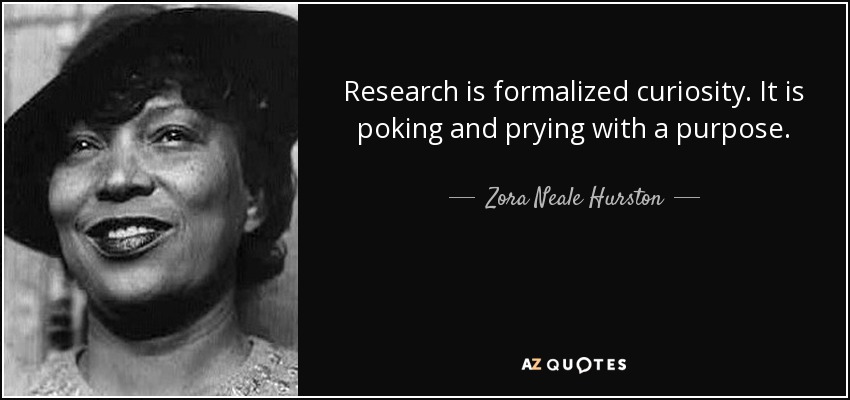
A good working definition of research might be:
Research is the deliberate, purposeful, and systematic gathering of data, information, facts, and/or opinions for the advancement of personal, societal, or overall human knowledge.
Based on this definition, we all do research all the time. Most of this research is casual research. Asking friends what they think of different restaurants, looking up reviews of various products online, learning more about celebrities; these are all research.
Formal research includes the type of research most people think of when they hear the term “research”: scientists in white coats working in a fully equipped laboratory. But formal research is a much broader category that just this. Most people will never do laboratory research after graduating from college, but almost everybody will have to do some sort of formal research at some point in their careers.
Casual research is inward facing: it’s done to satisfy our own curiosity or meet our own needs, whether that’s choosing a reliable car or figuring out what to watch on TV. Formal research is outward facing. While it may satisfy our own curiosity, it’s primarily intended to be shared in order to achieve some purpose. That purpose could be anything: finding a cure for cancer, securing funding for a new business, improving some process at your workplace, proving the latest theory in quantum physics, or even just getting a good grade in your Humanities 200 class.
What sets formal research apart from casual research is the documentation of where you gathered your information from. This is done in the form of “citations” and “bibliographies.” Citing sources is covered in the section "Citing Your Sources."
Formal research also follows certain common patterns depending on what the research is trying to show or prove. These are covered in the section “Types of Research.”
- Next: TL;DR >>
- Last Updated: Jul 24, 2024 4:33 PM
- URL: https://guides.library.iit.edu/research_basics
More From Forbes
The role of research at universities: why it matters.
- Share to Facebook
- Share to Twitter
- Share to Linkedin
(Photo by William B. Plowman/Getty Images)
Teaching and learning, research and discovery, synthesis and creativity, understanding and engagement, service and outreach. There are many “core elements” to the mission of a great university. Teaching would seem the most obvious, but for those outside of the university, “research” (taken to include scientific research, scholarship more broadly, as well as creative activity) may be the least well understood. This creates misunderstanding of how universities invest resources, especially those deriving from undergraduate tuition and state (or other public) support, and the misperception that those resources are being diverted away from what is believed should be the core (and sole) focus, teaching. This has led to a loss of trust, confidence, and willingness to continue to invest or otherwise support (especially our public) universities.
Why are universities engaged in the conduct of research? Who pays? Who benefits? And why does it all matter? Good questions. Let’s get to some straightforward answers. Because the academic research enterprise really is not that difficult to explain, and its impacts are profound.
So let’s demystify university-based research. And in doing so, hopefully we can begin building both better understanding and a better relationship between the public and higher education, both of which are essential to the future of US higher education.
Why are universities engaged in the conduct of research?
Universities engage in research as part of their missions around learning and discovery. This, in turn, contributes directly and indirectly to their primary mission of teaching. Universities and many colleges (the exception being those dedicated exclusively to undergraduate teaching) have as part of their mission the pursuit of scholarship. This can come in the form of fundamental or applied research (both are most common in the STEM fields, broadly defined), research-based scholarship or what often is called “scholarly activity” (most common in the social sciences and humanities), or creative activity (most common in the arts). Increasingly, these simple categorizations are being blurred, for all good reasons and to the good of the discovery of new knowledge and greater understanding of complex (transdisciplinary) challenges and the creation of increasingly interrelated fields needed to address them.
It goes without saying that the advancement of knowledge (discovery, innovation, creation) is essential to any civilization. Our nation’s research universities represent some of the most concentrated communities of scholars, facilities, and collective expertise engaged in these activities. But more importantly, this is where higher education is delivered, where students develop breadth and depth of knowledge in foundational and advanced subjects, where the skills for knowledge acquisition and understanding (including contextualization, interpretation, and inference) are honed, and where students are educated, trained, and otherwise prepared for successful careers. Part of that training and preparation derives from exposure to faculty who are engaged at the leading-edge of their fields, through their research and scholarly work. The best faculty, the teacher-scholars, seamlessly weave their teaching and research efforts together, to their mutual benefit, and in a way that excites and engages their students. In this way, the next generation of scholars (academic or otherwise) is trained, research and discovery continue to advance inter-generationally, and the cycle is perpetuated.
Best High-Yield Savings Accounts Of 2024
Best 5% interest savings accounts of 2024.
University research can be expensive, particularly in laboratory-intensive fields. But the responsibility for much (indeed most) of the cost of conducting research falls to the faculty member. Faculty who are engaged in research write grants for funding (e.g., from federal and state agencies, foundations, and private companies) to support their work and the work of their students and staff. In some cases, the universities do need to invest heavily in equipment, facilities, and personnel to support select research activities. But they do so judiciously, with an eye toward both their mission, their strategic priorities, and their available resources.
Medical research, and medical education more broadly, is expensive and often requires substantial institutional investment beyond what can be covered by clinical operations or externally funded research. But universities with medical schools/medical centers have determined that the value to their educational and training missions as well as to their communities justifies the investment. And most would agree that university-based medical centers are of significant value to their communities, often providing best-in-class treatment and care in midsize and smaller communities at a level more often seen in larger metropolitan areas.
Research in the STEM fields (broadly defined) can also be expensive. Scientific (including medical) and engineering research often involves specialized facilities or pieces of equipment, advanced computing capabilities, materials requiring controlled handling and storage, and so forth. But much of this work is funded, in large part, by federal agencies such as the National Science Foundation, National Institutes of Health, US Department of Energy, US Department of Agriculture, and many others.
Research in the social sciences is often (not always) less expensive, requiring smaller amount of grant funding. As mentioned previously, however, it is now becoming common to have physical, natural, and social scientist teams pursuing large grant funding. This is an exciting and very promising trend for many reasons, not the least of which is the nature of the complex problems being studied.
Research in the arts and humanities typically requires the least amount of funding as it rarely requires the expensive items listed previously. Funding from such organizations as the National Endowment for the Arts, National Endowment for the Humanities, and private foundations may be able to support significant scholarship and creation of new knowledge or works through much more modest grants than would be required in the natural or physical sciences, for example.
Philanthropy may also be directed toward the support of research and scholarly activity at universities. Support from individual donors, family foundations, private or corporate foundations may be directed to support students, faculty, labs or other facilities, research programs, galleries, centers, and institutes.
Who benefits?
Students, both undergraduate and graduate, benefit from studying in an environment rich with research and discovery. Besides what the faculty can bring back to the classroom, there are opportunities to engage with faculty as part of their research teams and even conduct independent research under their supervision, often for credit. There are opportunities to learn about and learn on state-of-the-art equipment, in state-of-the-art laboratories, and from those working on the leading edge in a discipline. There are opportunities to co-author, present at conferences, make important connections, and explore post-graduate pathways.
The broader university benefits from active research programs. Research on timely and important topics attracts attention, which in turn leads to greater institutional visibility and reputation. As a university becomes known for its research in certain fields, they become magnets for students, faculty, grants, media coverage, and even philanthropy. Strength in research helps to define a university’s “brand” in the national and international marketplace, impacting everything from student recruitment, to faculty retention, to attracting new investments.
The community, region, and state benefits from the research activity of the university. This is especially true for public research universities. Research also contributes directly to economic development, clinical, commercial, and business opportunities. Resources brought into the university through grants and contracts support faculty, staff, and student salaries, often adding additional jobs, contributing directly to the tax base. Research universities, through their expertise, reputation, and facilities, can attract new businesses into their communities or states. They can also launch and incubate startup companies, or license and sell their technologies to other companies. Research universities often host meeting and conferences which creates revenue for local hotels, restaurants, event centers, and more. And as mentioned previously, university medical centers provide high-quality medical care, often in midsize communities that wouldn’t otherwise have such outstanding services and state-of-the-art facilities.
(Photo by Justin Sullivan/Getty Images)
And finally, why does this all matter?
Research is essential to advancing society, strengthening the economy, driving innovation, and addressing the vexing and challenging problems we face as a people, place, and planet. It’s through research, scholarship, and discovery that we learn about our history and ourselves, understand the present context in which we live, and plan for and secure our future.
Research universities are vibrant, exciting, and inspiring places to learn and to work. They offer opportunities for students that few other institutions can match – whether small liberal arts colleges, mid-size teaching universities, or community colleges – and while not right for every learner or every educator, they are right for many, if not most. The advantages simply cannot be ignored. Neither can the importance or the need for these institutions. They need not be for everyone, and everyone need not find their way to study or work at our research universities, and we stipulate that there are many outstanding options to meet and support different learning styles and provide different environments for teaching and learning. But it’s critically important that we continue to support, protect, and respect research universities for all they do for their students, their communities and states, our standing in the global scientific community, our economy, and our nation.

- Editorial Standards
- Reprints & Permissions
Join The Conversation
One Community. Many Voices. Create a free account to share your thoughts.
Forbes Community Guidelines
Our community is about connecting people through open and thoughtful conversations. We want our readers to share their views and exchange ideas and facts in a safe space.
In order to do so, please follow the posting rules in our site's Terms of Service. We've summarized some of those key rules below. Simply put, keep it civil.
Your post will be rejected if we notice that it seems to contain:
- False or intentionally out-of-context or misleading information
- Insults, profanity, incoherent, obscene or inflammatory language or threats of any kind
- Attacks on the identity of other commenters or the article's author
- Content that otherwise violates our site's terms.
User accounts will be blocked if we notice or believe that users are engaged in:
- Continuous attempts to re-post comments that have been previously moderated/rejected
- Racist, sexist, homophobic or other discriminatory comments
- Attempts or tactics that put the site security at risk
- Actions that otherwise violate our site's terms.
So, how can you be a power user?
- Stay on topic and share your insights
- Feel free to be clear and thoughtful to get your point across
- ‘Like’ or ‘Dislike’ to show your point of view.
- Protect your community.
- Use the report tool to alert us when someone breaks the rules.
Thanks for reading our community guidelines. Please read the full list of posting rules found in our site's Terms of Service.
Search Stanford:
Other ways to search: Map Profiles
Main Content
From Nobel Prize winners to undergraduates, all members of the Stanford community are engaged in the creation of knowledge.
The Research Enterprise
Stanford’s culture of collaboration drives innovative discoveries in areas vital to our world, our health, and our intellectual life.
Interdisciplinary Research
At the intersection of disciplines is where new ideas emerge and innovative research happens.
Stanford Research
Institutes, Labs & Centers
Fifteen independent labs, centers, and institutes engage faculty and students from across the university.
Independent Laboratories, Centers and Institutes
Other Research Centers & Labs
Academic departments sponsor numerous other research centers and labs.
Listing of Stanford Research Centers
Where Research Happens
SLAC National Accelerator Laboratory
SLAC is a U.S. Department of Energy national laboratory operated by Stanford, conducting research in chemistry, materials and energy sciences, bioscience, fusion energy science, high-energy physics, cosmology and other fields.
Hoover Institution
The Hoover Institution, devoted to the study of domestic and international affairs, was founded in 1919 by Herbert Hoover, a member of Stanford’s pioneer class of 1895 and the 31st U.S. president.
Stanford Woods Institute for the Environment
Working toward a future in which societies meet people’s needs for water, food and health while protecting and nurturing the planet.
Stanford Woods Institute
Stanford Humanities Center
Advancing research into the historical, philosophical, literary, artistic, and cultural dimensions of the human experience.
Stanford Bio-X
Biomedical and life science researchers, clinicians, engineers, physicists and computational scientists come together to unlock the secrets of the human body.
Freeman Spogli Institute for International Studies (FSI)
Understanding problems, policies and processes that cross borders and affect lives around the world.
Freeman Spogli Institute
Stanford University Libraries
Stanford is home to more than 20 individual libraries, each with a world-class collection of books, journals, films, maps and databases.
Online Catalog
SearchWorks is Stanford University Libraries’ official online search tool providing metadata about the 8 million+ resources in our physical and online collections.
SearchWorks
Undergraduate Research
Undergraduate Advising and Research (UAR) connects undergraduates with faculty to conduct research, advanced scholarship, and creative projects.
Research Administration
The Office of the Vice Provost and Dean of Research, provides comprehensive information about the research enterprise at Stanford.
Find A Researcher
Search and read profiles of Stanford faculty, staff, students, and postdocs. Find researchers with whom you would like to collaborate.
Stanford Profiles
Research & Innovation
With more than $1.37 billion in annual R&D expenditures, Penn is one of the nation’s top research universities, not only generating important new knowledge in the fields of medicine, technology, business, science, and beyond, but applying this knowledge to improve the lives of individuals and communities at home and around the world. Innovative research that yields actionable knowledge is one of the cornerstones of Penn's vision for the future of the University.
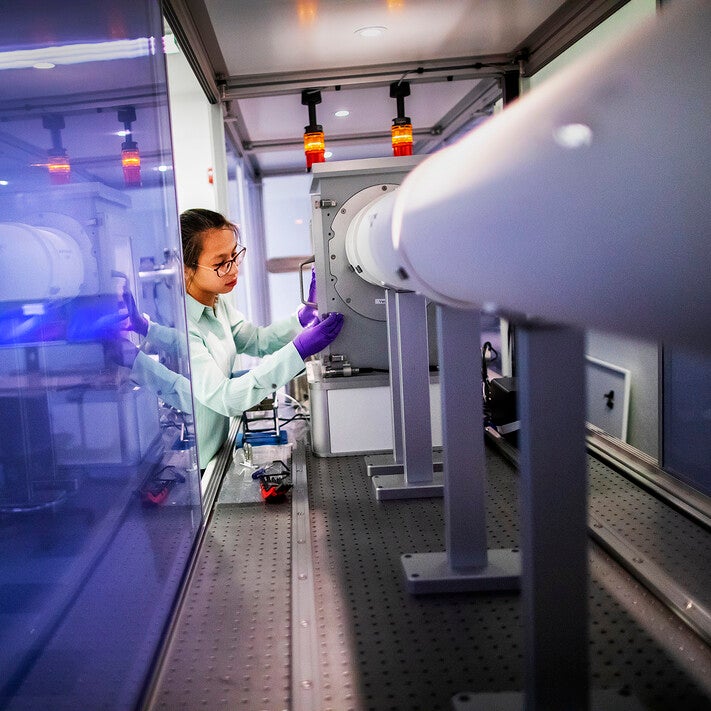
Research Facts
Office of the vice provost for research.
The Vice Provost for Research is an adviser to the Provost and has oversight of the University’s vast research enterprise, encompassing a broad spectrum of research support services, regulatory bodies, multi-disciplinary campus-wide Centers and Institutes, and partnerships to further develop investigator inventions. OVPR collaborates with Penn constituents and external partners to promote meaningful scholarship, uphold research integrity, and foster new discoveries.
Centers & Institutes
The investigative collaborations that take place at Penn represent some of today’s most cutting-edge interdisciplinary research. Explore the centers and institutes that are generating new knowledge all over campus, and learn about the powerful impact this Penn-generated knowledge is making in all corners of the world.
Compliance & Training
OVPR is charged with oversight responsibility for multiple regulatory compliance areas at Penn. Given the breadth of regulations and guidelines, research compliance is a shared responsibility between numerous University offices.
OVPR manages a number of internal funding opportunities on behalf of the University as well as access to external funding opportunities.
Research Excellence Initiative
The Penn Research Excellence Initiative, spearheaded by OVPR, is a program that supports research credibility and integrity on Penn’s campus and across the Philadelphia region.
Services For Researchers (Research Portal)
Penn's Research Portal is a centralized compendium of University-wide research-related links.
Office for the Vice Provost for Research
Suite 118 College Hall University of Pennsylvania Philadelphia, PA 19104-6376 Monday-Friday: 9am - 5pm
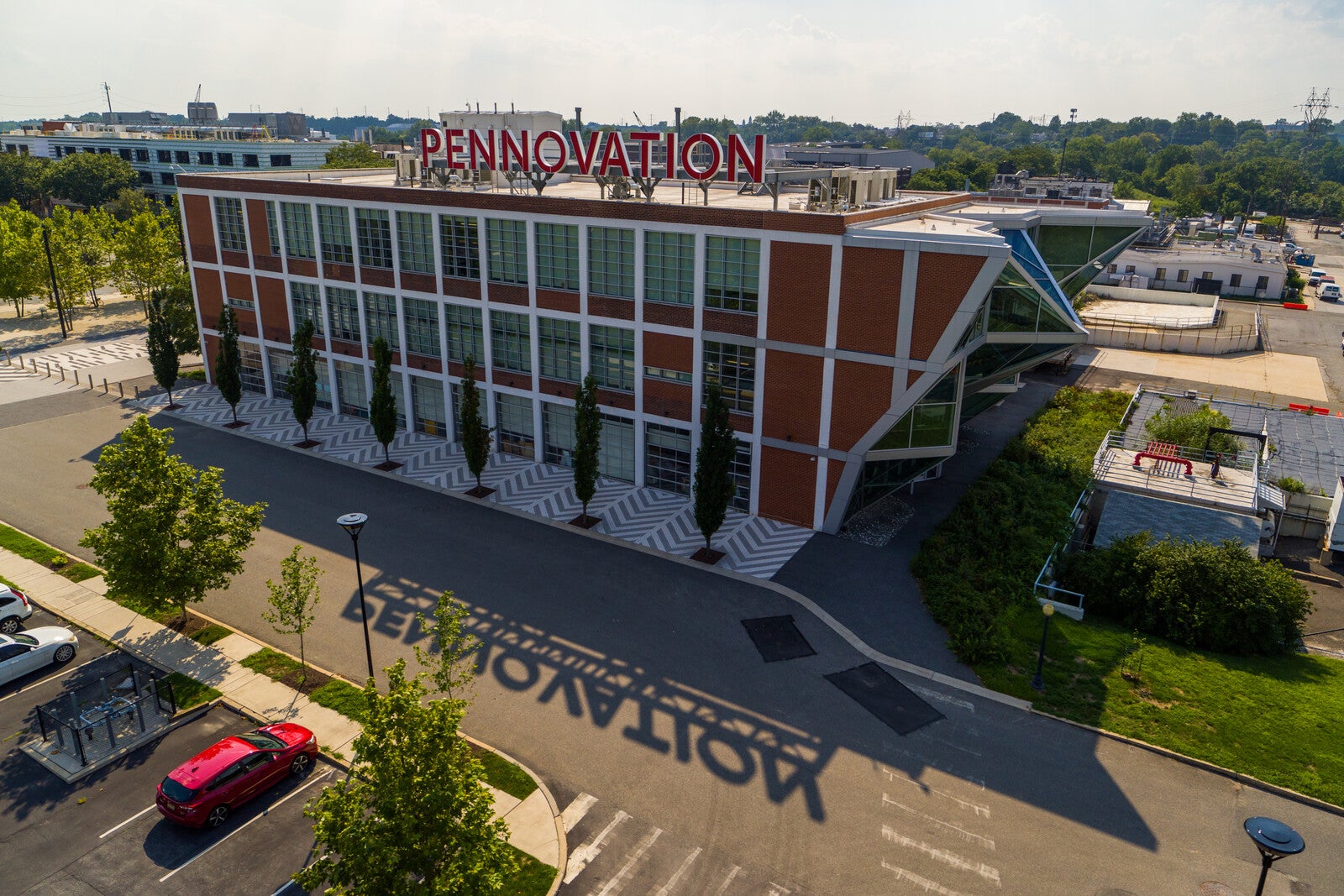
Penn Center for Innovation
PCI works in partnership with Penn faculty, staff, and students to advance scientific breakthroughs and technological advances toward new products, services, and/or businesses that provide benefits back to Penn, its inventors, and society.
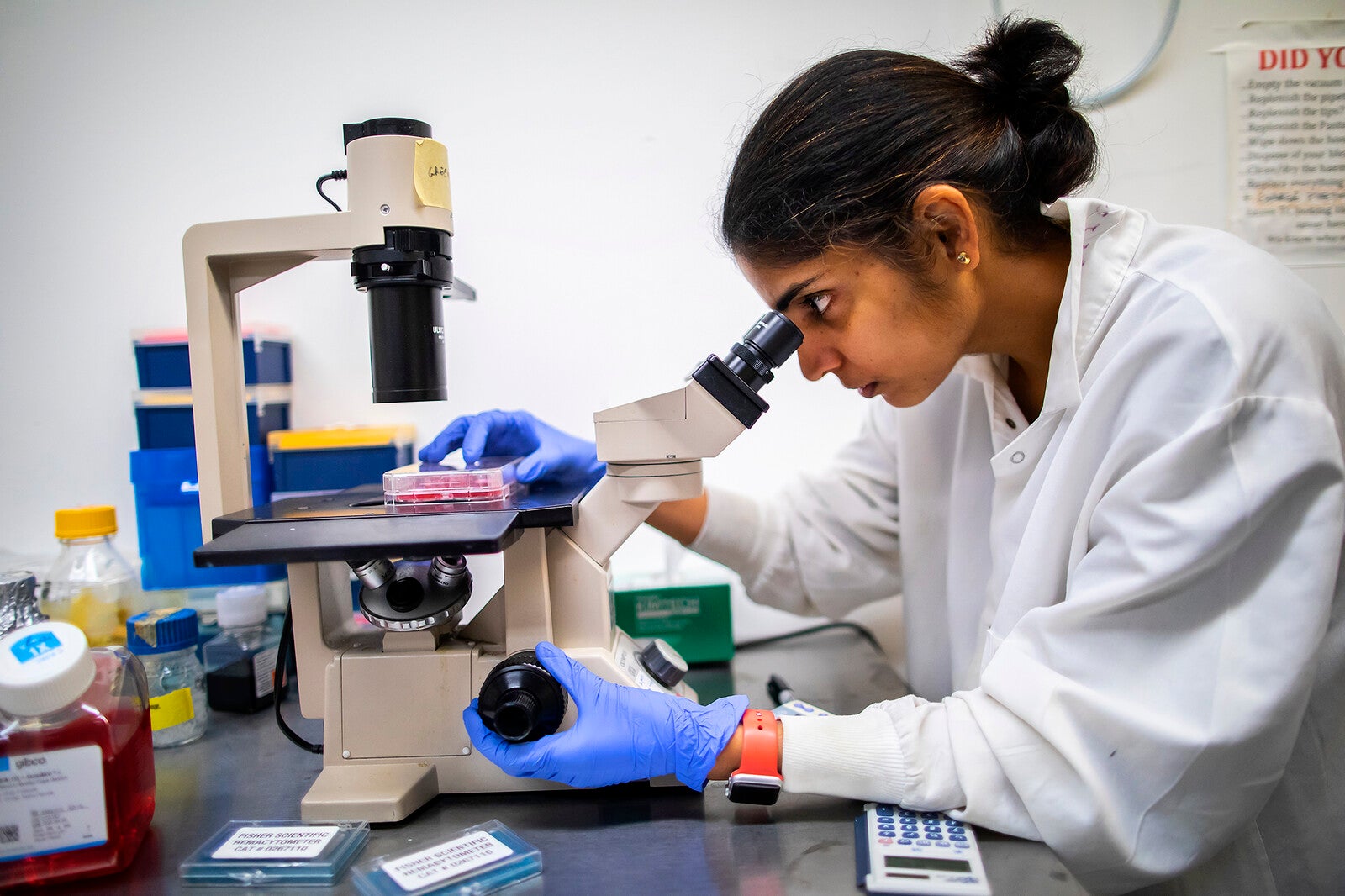
Center for Undergraduate Research and Fellowships
CURF supports students as they pursue transformative experiences through fellowships, scholars programs, and undergraduate research. CURF promotes connections between faculty and students, encourages mentorship, and educates the Penn community about opportunities.
Research at Penn
As one of the top research universities in the world, Penn generates important new knowledge in medicine, technology, business, social science, humanities, and beyond, and applies this knowledge to improve the lives of individuals and communities at home and around the globe. Research at Penn is an annual publication that highlights some of the groundbreaking and innovative research happening across the University’s 12 schools.
Download the PDF
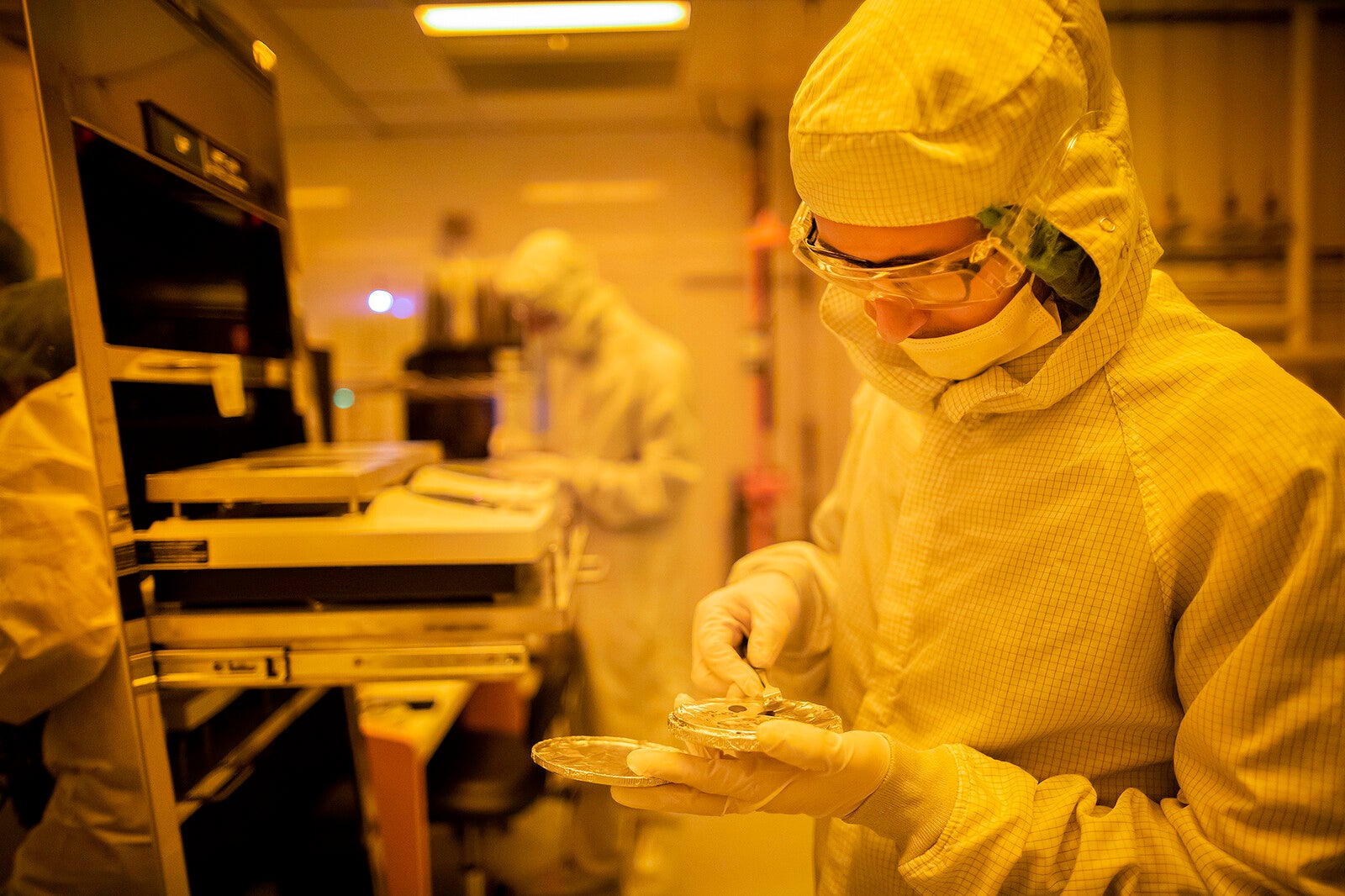

U of A research and discovery continues year-round.
Stay connected through featured stories, interviews, and more.
Impact in Action Newsletter Research News
Impact in Action Newsletter
Research News
Arizona Research, Innovation & Impact
The Office for Research, Innovation and Impact advances the world-class research enterprise at the University of Arizona, a top-ranking public institution with over $955M in annual research expenditures. Our bold, forward-thinking innovators are focused on transformational discoveries and inventions that address the world’s most complex, pressing challenges.
We support researchers with resources, training, and specialized facilities, and foster collaboration across disciplines through university institutes and centers.
By providing hands-on research opportunities, direct access to faculty and professional mentorship, and programs that help encourage an entrepreneurial mindset, we prepare students to leave the university and thrive.
Through an unwavering commitment to our land-grand mission, we stimulate economic development, societal impact, and improved life and health in Arizona and beyond.
Read more about who we are and what we do.
As a top-ranking public institution with $955M in annual research activity, we are pushing the boundaries of knowledge and innovation.
The Research Enterprise at a Glance
NASA-funded activity
in Earth Sciences
water resources research
patents issued
start-ups launched
geography research
More Highlights & Rankings
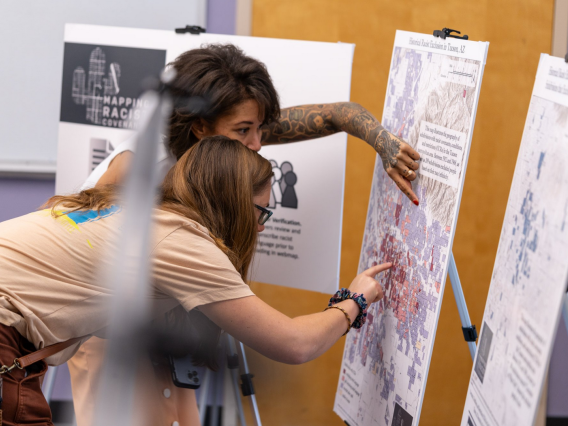
Mapping Racist Covenants: How a UArizona geographer's research informed a new Arizona law
A project led by Jason Jurjevich informed a law that lets homeowners remove unlawful restrictions from their property records.

University of Arizona selected to participate in NSF-NobleReach Emerge partnership aimed at speeding biotechnology development and translation
Arizona is the only institution with two projects chosen for pilot program that pairs research teams with entrepreneurial experts in effort to establish long-term financial viability

University of Arizona Maricopa County Cooperative Extension Receives USDA Grant for Urban Beekeeping Education
The University of Arizona received a $100,000 grant from the USDA to develop a program that serves underrepresented urban farmers by teaching them to pollinate their crops through beekeeping and to diversify their income with honeybee products.
More News Stories
The Innovation Ecosystem
Tech parks arizona.
Connects Companies with the U of A
Tech Launch Arizona
Creates Impact from University Innovation
Center for Innovation
Grows Science and Tech Startups
- Supports scaling of science and tech companies through purpose-built environments
- Attracts new investments that deliver quality jobs and lead to collaborative research
- Drives annual $2B economic impact through support of university-industry relationships
techparks.arizona.edu
- Engages U of A innovators to advance inventions from lab to marketplace
- Protects and licenses university inventions
- Supports creation of startups and a connected innovation ecosystem
techlaunch.arizona.edu
- Provides customized startup support through 28-point roadmap
- Helps secure investments through regional, state, and national funding vehicles
- Supports businesses seeking U.S. market entry through accredited Soft Landing program
Centers and Institutes

All Centers and Institutes
Upcoming Events
The Vault Show: New Acquisitions
September 2024 research support services orientation, connect with us.
Be the first to read featured stories and stay on top of events that connect you with The University of Arizona's research, innovation, entrepreneurial ventures, and societal impacts.
Find Us on Social Media
X, formerly twitter, arizona impact in action newsletter.
Subscribe Now
Research shows our bodies go through rapid changes in our 40s and our 60s
For many people, reaching their mid-40s may bring unpleasant signs the body isn’t working as well as it once did. Injuries seem to happen more frequently. Muscles may feel weaker.
A new study, published Wednesday in Nature Aging , shows what may be causing the physical decline. Researchers have found that molecules and microorganisms both inside and outside our bodies are going through dramatic changes, first at about age 44 and then again when we hit 60. Those alterations may be causing significant differences in cardiovascular health and immune function.
The findings come from Stanford scientists who analyzed blood and other biological samples of 108 volunteers ages 25 to 75, who continued to donate samples for several years.
“While it’s obvious that you’re aging throughout your entire life, there are two big periods where things really shift,” said the study’s senior author, Michael Snyder, a professor of genetics and director of the Center for Genomics and Personalized Medicine at Stanford Medicine. For example, “there’s a big shift in the metabolism of lipids when people are in their 40s and in the metabolism of carbohydrates when people are in their 60s.”
Lipids are fatty substances, including LDL, HDL and triglycerides, that perform a host of functions in the body, but they can be harmful if they build up in the blood.
The scientists tracked many kinds of molecules in the samples, including RNA and proteins, as well as the participants’ microbiomes.
The metabolic changes the researchers discovered indicate not that people in their 40s are burning calories more slowly but rather that the body is breaking food down differently. The scientists aren’t sure exactly what impact those changes have on health.
Previous research showed that resting energy use, or metabolic rate , didn’t change from ages 20 to 60. The new study’s findings don't contradict that.
The changes in metabolism affect how the body reacts to alcohol or caffeine, although the health consequences aren’t yet clear. In the case of caffeine, it may result in higher sensitivity.
It’s also not known yet whether the shifts could be linked to lifestyle or behavioral factors. For example, the changes in alcohol metabolism might be because people are drinking more in their mid-40s, Snyder said.
For now, Snyder suggests people in their 40s keep a close eye on their lipids, especially LDL cholesterol.
“If they start going up, people might want to think about taking statins if that’s what their doctor recommends,” he said. Moreover, “knowing there’s a shift in the molecules that affect muscles and skin, you might want to warm up more before exercising so you don’t hurt yourself.”
Until we know better what those changes mean, the best way to deal with them would be to eat healthy foods and to exercise regularly, Snyder said.Dr. Josef Coresh, founding director of the Optimal Aging Institute at the NYU Grossman School of Medicine, compared the new findings to the invention of the microscope.
“The beauty of this type of paper is the level of detail we can see in molecular changes,” said Coresh, a professor of medicine at the school. “But it will take time to sort out what individual changes mean and how we can tailor medications to those changes. We do know that the origins of many diseases happen in midlife when people are in their 40s, though the disease may occur decades later.”
The new study “is an important step forward,” said Dr. Lori Zeltser, a professor of pathology and cell biology at the Columbia University Vagelos College of Physicians and Surgeons. While we don’t know what the consequences of those metabolic changes are yet, “right now, we have to acknowledge that we metabolize food differently in our 40s, and that is something really new.”
The shifts the researchers found might help explain numerous age-related health changes, such as muscle loss, because “your body is breaking down food differently,” Zeltser said.
Linda Carroll is a regular health contributor to NBC News. She is coauthor of "The Concussion Crisis: Anatomy of a Silent Epidemic" and "Out of the Clouds: The Unlikely Horseman and the Unwanted Colt Who Conquered the Sport of Kings."

Think you know Penn State Research?
Think again..
We challenge the standards of science, sustainability, space, technology, the arts, and social solutions. We are your university for solutions , innovation , and partnership .
Senior VP for Research
Andrew read.

We are dedicated to the “long game” of research across our enterprise. This means we are focused on impact and not only on scientific results or publications. Penn State Research brings solutions and innovations which result in visible changes in our communities, global health, economic wellness, humanitarian efforts and worldwide positioning against our most difficult issues, over many years to come. It’s time to understand the true impact of our research enterprise.”
Who is the SVP for Research and what does he do?
We are an interdisciplinary research powerhouse.
Our research prowess is enabled through our seven interdisciplinary research institutes , our powerful Applied Research Laboratory , and the scientific caliber of our 18 colleges which all perform research from STEM to the arts, law, and communications.
$1.239 Billion
2022 - 2023 Research Expenditures
Nationwide for Research Expenditures
Industry Partnerships in the last decade
Industry research projects since 2013
Penn State ranks #3 in the nation in the breadth and depth of its research enterprise, as measured by the number of top-10 rankings in key fields.
Materials Engineering
Mechanical Engineering
Materials Science
Electrical Engineering
Total Engineering
Aerospace Engineering
Computer Science
Mathematics and Statistics
Biomedical Engineering
Atmospheric Science and Meteorology
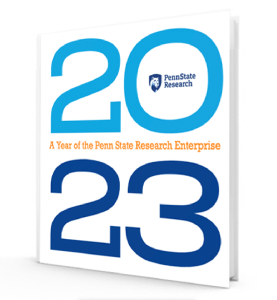
Research Magazine
Stories and accomplishments from a year of the Penn State Research Enterprise.
Search our research database to discover publications in major journals, find faculty, and read the most recent news.
What's the big news, $20m nsf grant to support center to study how complex biological processes arise, penn state, morgan advanced materials partner to improve semiconductor materials, andrew read named senior vice president for research, penntap releases 2023 annual report, different types of bladder cancer cells share common genetic ancestry, worlds collide: art history and materials science in the yucatán, who are we.
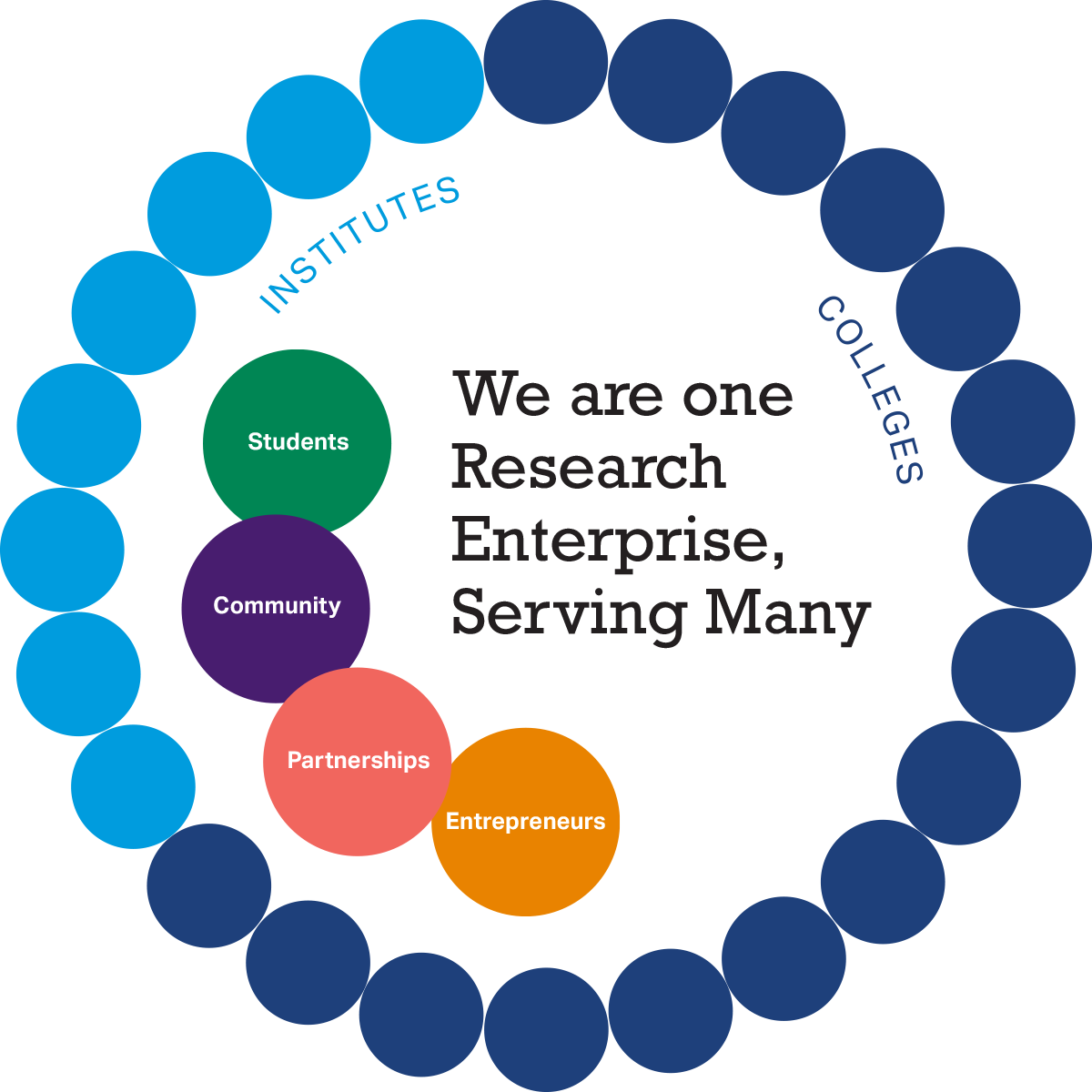
- College of Education
- Applied Research Laboratory
- Institute for Computational and Data Sciences
- Clinical and Translational Science Institute
- Institute of Energy and the Environment
- Social Science Research Institute
- Materials Research Institute
- Huck Institutes of the Life Sciences
Penn State Cancer Institute
- Penn State College of Medicine
- Nese College of Nursing
- Eberly College of Science
- Liberal Arts
- Donald P. Bellisario College of Communications
- School of International Affairs
Health & Human Development
- Information Sciences and Technology
- Dickinson Law
- Penn State Law
- Engineering
Earth & Mineral Sciences
- Smeal College of Business
Arts & Architecture
- Agricultural Sciences
Applied Research Lab
- Cancer Institute
- Arts & Architecture
- Earth & Mineral Sciences
- Health & Human Development
How do we work with you?
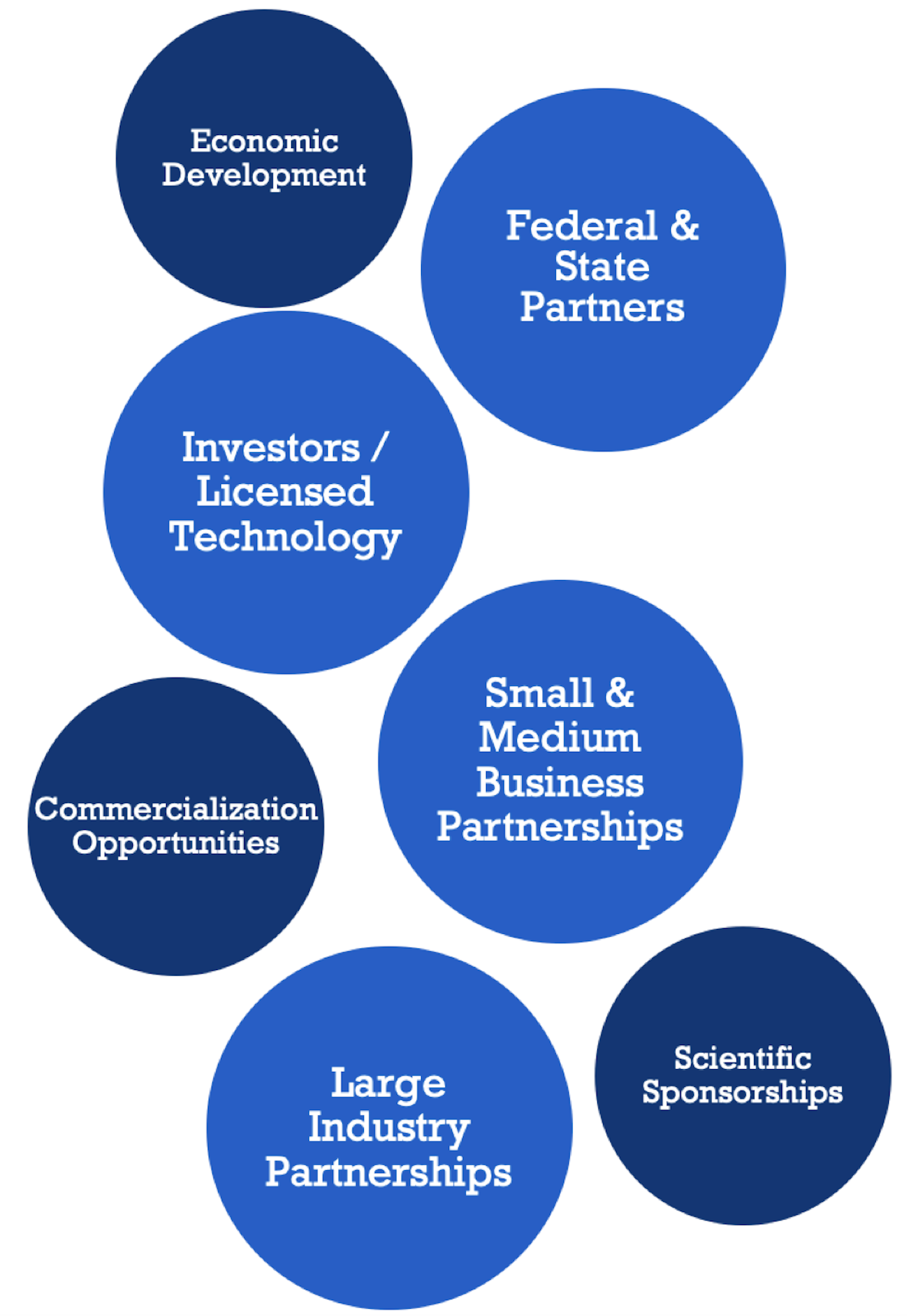
The Penn State Research Enterprise is an ecosystem where businesses, education, and research come together. In the past decade more than 2,000 companies have partnered with Penn State on over 9,000 projects.
Every Great Partnership Starts with a Connection.
Let’s get started.
There are many ways we can work and grow together. Here are just a few.
Involvement.
- Co-development of projects and grants
- Internships & Co-ops
- Student Training Programs
- Talent Pipeline Program
- Centers of Excellence
- Commercialization Opportunities
- License Technology
- Research Park and Incubation Facilities
- Core Facilities
- Student Consultant
- Hardware Grants
- Curriculum Dev
- Workshops/Seminars
- Student Org Sponsorship
- Student Mentorships
- Guest Speakers/Lecturers
Sponsorship
- Research projects
- New ventures
- Seed and venture funds
- Joint initiatives
- Student fellowships and scholarships
- Research consortiums
- Innovative facilities and equipment
- Outreach programs
Strategic Partner
- Cooperative business development
- Workforce development strategies
- Joint education-focused legislative petitioning
- Endowments and legacy opportunities
- Expanded talent pipeline
New Commercialization Opportunities
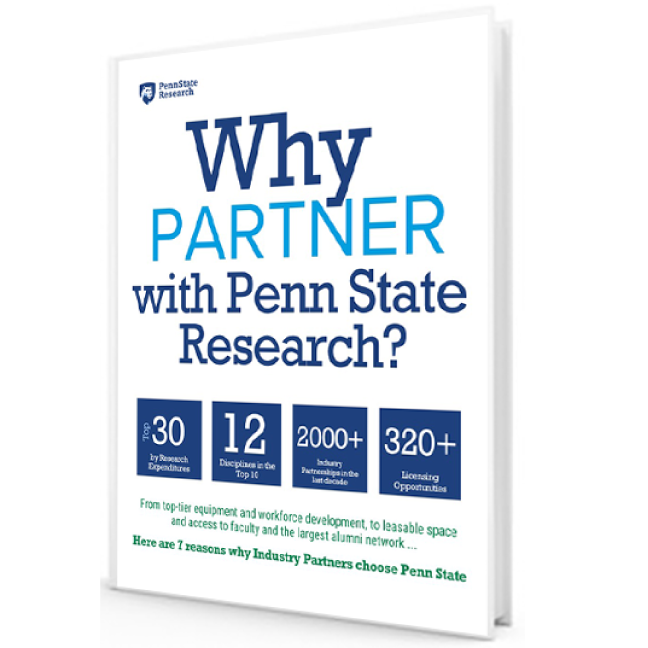
Here are 7 reasons why industry partners choose Penn State.
Companies and agencies large and small choose Penn State for equipment and workforce development, leasable space, and access to faculty and the largest alumni network in the world.
How do we impact our students?
Tomorrow’s brightest minds are working in Penn State research today. Research and creative inquiry opportunities exist in every discipline and in every year of academic study.
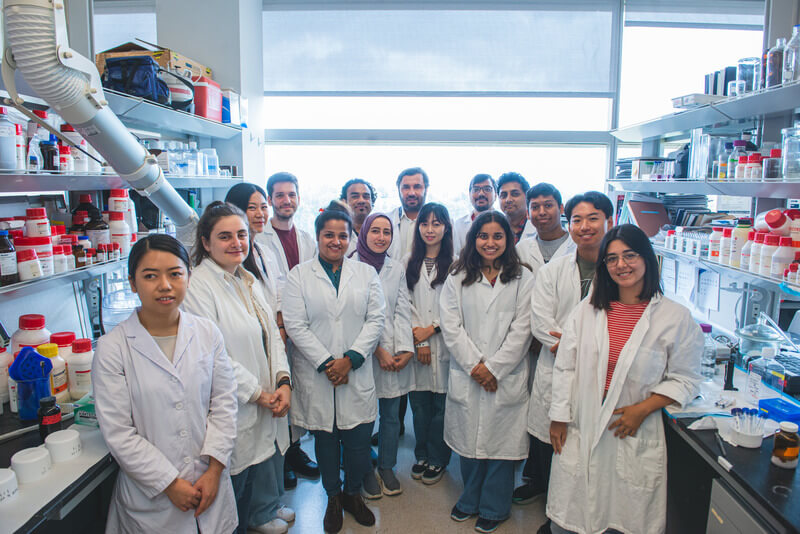
“I felt that Penn State was the best university for me to grow as a scientist and prepare for a future career.”
– Avery Sicher, 4th year graduate student
How does Philanthropy Advance Research?

Gifts to support research at Penn State are as varied as the questions being asked. From online contributions, to in-kind donations, and estate gifts — donors are cultivating curiosity across our institutes, colleges, and campuses.
Endowed faculty support advances research into the neuroscience of creativity
Tailored philanthropy empowers our students and faculty and helps donors build a lasting legacy.
Giving Tuesday donations support Pitch Exploration Lab
Online gifts support discovery and innovation across our research enterprise.
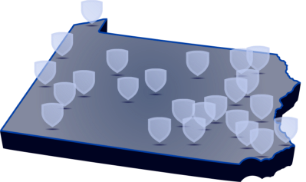
Office of the Senior Vice President
- Animal Resource Program
- Animal Diagnostic Lab
- Ben Franklin Technology Partners
- Corporate Engagement Center
- Invent Penn State
- Office of Entrepreneurship and Commercialization
- Office of Industrial Partnerships
- Office of Postdoctoral Affairs
- Office of Research Information Systems
- Office for Research Protections
- Office of Sponsored Programs
- Office of Technology Transfer
- Strategic Interdisciplinary Research Office
Interdisciplinary Research Institutes
Penn state colleges, become an advocate.
- Advocate Penn State
- Give to Penn State Research

- 304 Old Main, University Park, Pennsylvania 16802
- 814-863-9580
- Privacy Statement
- Non Discrimination
- Accessibility
- Equal Opportunity
- Legal Statements
- The Pennsylvania State University © 2023
Have a language expert improve your writing
Run a free plagiarism check in 10 minutes, generate accurate citations for free.
- Knowledge Base
Methodology
Research Methods | Definitions, Types, Examples
Research methods are specific procedures for collecting and analyzing data. Developing your research methods is an integral part of your research design . When planning your methods, there are two key decisions you will make.
First, decide how you will collect data . Your methods depend on what type of data you need to answer your research question :
- Qualitative vs. quantitative : Will your data take the form of words or numbers?
- Primary vs. secondary : Will you collect original data yourself, or will you use data that has already been collected by someone else?
- Descriptive vs. experimental : Will you take measurements of something as it is, or will you perform an experiment?
Second, decide how you will analyze the data .
- For quantitative data, you can use statistical analysis methods to test relationships between variables.
- For qualitative data, you can use methods such as thematic analysis to interpret patterns and meanings in the data.
Table of contents
Methods for collecting data, examples of data collection methods, methods for analyzing data, examples of data analysis methods, other interesting articles, frequently asked questions about research methods.
Data is the information that you collect for the purposes of answering your research question . The type of data you need depends on the aims of your research.
Qualitative vs. quantitative data
Your choice of qualitative or quantitative data collection depends on the type of knowledge you want to develop.
For questions about ideas, experiences and meanings, or to study something that can’t be described numerically, collect qualitative data .
If you want to develop a more mechanistic understanding of a topic, or your research involves hypothesis testing , collect quantitative data .
| Qualitative | to broader populations. . | |
|---|---|---|
| Quantitative | . |
You can also take a mixed methods approach , where you use both qualitative and quantitative research methods.
Primary vs. secondary research
Primary research is any original data that you collect yourself for the purposes of answering your research question (e.g. through surveys , observations and experiments ). Secondary research is data that has already been collected by other researchers (e.g. in a government census or previous scientific studies).
If you are exploring a novel research question, you’ll probably need to collect primary data . But if you want to synthesize existing knowledge, analyze historical trends, or identify patterns on a large scale, secondary data might be a better choice.
| Primary | . | methods. |
|---|---|---|
| Secondary |
Descriptive vs. experimental data
In descriptive research , you collect data about your study subject without intervening. The validity of your research will depend on your sampling method .
In experimental research , you systematically intervene in a process and measure the outcome. The validity of your research will depend on your experimental design .
To conduct an experiment, you need to be able to vary your independent variable , precisely measure your dependent variable, and control for confounding variables . If it’s practically and ethically possible, this method is the best choice for answering questions about cause and effect.
| Descriptive | . . | |
|---|---|---|
| Experimental |
Receive feedback on language, structure, and formatting
Professional editors proofread and edit your paper by focusing on:
- Academic style
- Vague sentences
- Style consistency
See an example

| Research method | Primary or secondary? | Qualitative or quantitative? | When to use |
|---|---|---|---|
| Primary | Quantitative | To test cause-and-effect relationships. | |
| Primary | Quantitative | To understand general characteristics of a population. | |
| Interview/focus group | Primary | Qualitative | To gain more in-depth understanding of a topic. |
| Observation | Primary | Either | To understand how something occurs in its natural setting. |
| Secondary | Either | To situate your research in an existing body of work, or to evaluate trends within a research topic. | |
| Either | Either | To gain an in-depth understanding of a specific group or context, or when you don’t have the resources for a large study. |
Your data analysis methods will depend on the type of data you collect and how you prepare it for analysis.
Data can often be analyzed both quantitatively and qualitatively. For example, survey responses could be analyzed qualitatively by studying the meanings of responses or quantitatively by studying the frequencies of responses.
Qualitative analysis methods
Qualitative analysis is used to understand words, ideas, and experiences. You can use it to interpret data that was collected:
- From open-ended surveys and interviews , literature reviews , case studies , ethnographies , and other sources that use text rather than numbers.
- Using non-probability sampling methods .
Qualitative analysis tends to be quite flexible and relies on the researcher’s judgement, so you have to reflect carefully on your choices and assumptions and be careful to avoid research bias .
Quantitative analysis methods
Quantitative analysis uses numbers and statistics to understand frequencies, averages and correlations (in descriptive studies) or cause-and-effect relationships (in experiments).
You can use quantitative analysis to interpret data that was collected either:
- During an experiment .
- Using probability sampling methods .
Because the data is collected and analyzed in a statistically valid way, the results of quantitative analysis can be easily standardized and shared among researchers.
| Research method | Qualitative or quantitative? | When to use |
|---|---|---|
| Quantitative | To analyze data collected in a statistically valid manner (e.g. from experiments, surveys, and observations). | |
| Meta-analysis | Quantitative | To statistically analyze the results of a large collection of studies. Can only be applied to studies that collected data in a statistically valid manner. |
| Qualitative | To analyze data collected from interviews, , or textual sources. To understand general themes in the data and how they are communicated. | |
| Either | To analyze large volumes of textual or visual data collected from surveys, literature reviews, or other sources. Can be quantitative (i.e. frequencies of words) or qualitative (i.e. meanings of words). |
Prevent plagiarism. Run a free check.
If you want to know more about statistics , methodology , or research bias , make sure to check out some of our other articles with explanations and examples.
- Chi square test of independence
- Statistical power
- Descriptive statistics
- Degrees of freedom
- Pearson correlation
- Null hypothesis
- Double-blind study
- Case-control study
- Research ethics
- Data collection
- Hypothesis testing
- Structured interviews
Research bias
- Hawthorne effect
- Unconscious bias
- Recall bias
- Halo effect
- Self-serving bias
- Information bias
Quantitative research deals with numbers and statistics, while qualitative research deals with words and meanings.
Quantitative methods allow you to systematically measure variables and test hypotheses . Qualitative methods allow you to explore concepts and experiences in more detail.
In mixed methods research , you use both qualitative and quantitative data collection and analysis methods to answer your research question .
A sample is a subset of individuals from a larger population . Sampling means selecting the group that you will actually collect data from in your research. For example, if you are researching the opinions of students in your university, you could survey a sample of 100 students.
In statistics, sampling allows you to test a hypothesis about the characteristics of a population.
The research methods you use depend on the type of data you need to answer your research question .
- If you want to measure something or test a hypothesis , use quantitative methods . If you want to explore ideas, thoughts and meanings, use qualitative methods .
- If you want to analyze a large amount of readily-available data, use secondary data. If you want data specific to your purposes with control over how it is generated, collect primary data.
- If you want to establish cause-and-effect relationships between variables , use experimental methods. If you want to understand the characteristics of a research subject, use descriptive methods.
Methodology refers to the overarching strategy and rationale of your research project . It involves studying the methods used in your field and the theories or principles behind them, in order to develop an approach that matches your objectives.
Methods are the specific tools and procedures you use to collect and analyze data (for example, experiments, surveys , and statistical tests ).
In shorter scientific papers, where the aim is to report the findings of a specific study, you might simply describe what you did in a methods section .
In a longer or more complex research project, such as a thesis or dissertation , you will probably include a methodology section , where you explain your approach to answering the research questions and cite relevant sources to support your choice of methods.
Is this article helpful?
Other students also liked, writing strong research questions | criteria & examples.
- What Is a Research Design | Types, Guide & Examples
- Data Collection | Definition, Methods & Examples
More interesting articles
- Between-Subjects Design | Examples, Pros, & Cons
- Cluster Sampling | A Simple Step-by-Step Guide with Examples
- Confounding Variables | Definition, Examples & Controls
- Construct Validity | Definition, Types, & Examples
- Content Analysis | Guide, Methods & Examples
- Control Groups and Treatment Groups | Uses & Examples
- Control Variables | What Are They & Why Do They Matter?
- Correlation vs. Causation | Difference, Designs & Examples
- Correlational Research | When & How to Use
- Critical Discourse Analysis | Definition, Guide & Examples
- Cross-Sectional Study | Definition, Uses & Examples
- Descriptive Research | Definition, Types, Methods & Examples
- Ethical Considerations in Research | Types & Examples
- Explanatory and Response Variables | Definitions & Examples
- Explanatory Research | Definition, Guide, & Examples
- Exploratory Research | Definition, Guide, & Examples
- External Validity | Definition, Types, Threats & Examples
- Extraneous Variables | Examples, Types & Controls
- Guide to Experimental Design | Overview, Steps, & Examples
- How Do You Incorporate an Interview into a Dissertation? | Tips
- How to Do Thematic Analysis | Step-by-Step Guide & Examples
- How to Write a Literature Review | Guide, Examples, & Templates
- How to Write a Strong Hypothesis | Steps & Examples
- Inclusion and Exclusion Criteria | Examples & Definition
- Independent vs. Dependent Variables | Definition & Examples
- Inductive Reasoning | Types, Examples, Explanation
- Inductive vs. Deductive Research Approach | Steps & Examples
- Internal Validity in Research | Definition, Threats, & Examples
- Internal vs. External Validity | Understanding Differences & Threats
- Longitudinal Study | Definition, Approaches & Examples
- Mediator vs. Moderator Variables | Differences & Examples
- Mixed Methods Research | Definition, Guide & Examples
- Multistage Sampling | Introductory Guide & Examples
- Naturalistic Observation | Definition, Guide & Examples
- Operationalization | A Guide with Examples, Pros & Cons
- Population vs. Sample | Definitions, Differences & Examples
- Primary Research | Definition, Types, & Examples
- Qualitative vs. Quantitative Research | Differences, Examples & Methods
- Quasi-Experimental Design | Definition, Types & Examples
- Questionnaire Design | Methods, Question Types & Examples
- Random Assignment in Experiments | Introduction & Examples
- Random vs. Systematic Error | Definition & Examples
- Reliability vs. Validity in Research | Difference, Types and Examples
- Reproducibility vs Replicability | Difference & Examples
- Reproducibility vs. Replicability | Difference & Examples
- Sampling Methods | Types, Techniques & Examples
- Semi-Structured Interview | Definition, Guide & Examples
- Simple Random Sampling | Definition, Steps & Examples
- Single, Double, & Triple Blind Study | Definition & Examples
- Stratified Sampling | Definition, Guide & Examples
- Structured Interview | Definition, Guide & Examples
- Survey Research | Definition, Examples & Methods
- Systematic Review | Definition, Example, & Guide
- Systematic Sampling | A Step-by-Step Guide with Examples
- Textual Analysis | Guide, 3 Approaches & Examples
- The 4 Types of Reliability in Research | Definitions & Examples
- The 4 Types of Validity in Research | Definitions & Examples
- Transcribing an Interview | 5 Steps & Transcription Software
- Triangulation in Research | Guide, Types, Examples
- Types of Interviews in Research | Guide & Examples
- Types of Research Designs Compared | Guide & Examples
- Types of Variables in Research & Statistics | Examples
- Unstructured Interview | Definition, Guide & Examples
- What Is a Case Study? | Definition, Examples & Methods
- What Is a Case-Control Study? | Definition & Examples
- What Is a Cohort Study? | Definition & Examples
- What Is a Conceptual Framework? | Tips & Examples
- What Is a Controlled Experiment? | Definitions & Examples
- What Is a Double-Barreled Question?
- What Is a Focus Group? | Step-by-Step Guide & Examples
- What Is a Likert Scale? | Guide & Examples
- What Is a Prospective Cohort Study? | Definition & Examples
- What Is a Retrospective Cohort Study? | Definition & Examples
- What Is Action Research? | Definition & Examples
- What Is an Observational Study? | Guide & Examples
- What Is Concurrent Validity? | Definition & Examples
- What Is Content Validity? | Definition & Examples
- What Is Convenience Sampling? | Definition & Examples
- What Is Convergent Validity? | Definition & Examples
- What Is Criterion Validity? | Definition & Examples
- What Is Data Cleansing? | Definition, Guide & Examples
- What Is Deductive Reasoning? | Explanation & Examples
- What Is Discriminant Validity? | Definition & Example
- What Is Ecological Validity? | Definition & Examples
- What Is Ethnography? | Definition, Guide & Examples
- What Is Face Validity? | Guide, Definition & Examples
- What Is Non-Probability Sampling? | Types & Examples
- What Is Participant Observation? | Definition & Examples
- What Is Peer Review? | Types & Examples
- What Is Predictive Validity? | Examples & Definition
- What Is Probability Sampling? | Types & Examples
- What Is Purposive Sampling? | Definition & Examples
- What Is Qualitative Observation? | Definition & Examples
- What Is Qualitative Research? | Methods & Examples
- What Is Quantitative Observation? | Definition & Examples
- What Is Quantitative Research? | Definition, Uses & Methods
What is your plagiarism score?
- SUGGESTED TOPICS
- The Magazine
- Newsletters
- Managing Yourself
- Managing Teams
- Work-life Balance
- The Big Idea
- Data & Visuals
- Reading Lists
- Case Selections
- HBR Learning
- Topic Feeds
- Account Settings
- Email Preferences
Research: What Happens When Influencers Turn Off Comments
- Michelle Daniels

Seven studies examined the effects on their personal brands and product endorsements.
Influencers are often targets of online negativity, and how they respond to this feedback can have important ramifications for their personal brands and the effectiveness of their product endorsements. Recent research shows that one commonly employed tactic — turning off social media comments — can undermine influencers’ key assets: their persuasiveness, likability, and perceived sincerity.
Public figures, from Oprah to Selena Gomez , have restricted access to their social media comments in response to online criticism, whether on a temporary or permanent basis. This decision seems rational; those in the public eye are often highly scrutinized, and disabling comments can be a first line of defense to protect their mental health.
- Freeman Wu is an assistant professor of marketing at Vanderbilt University. His research focuses on digital marketing, aesthetics and design, and social influence in consumption contexts.
- Michelle Daniels is an assistant professor of marketing at the University of Alabama. Her research focuses on social perception in digital spaces, with an emphasis on the intersection of consumption and well-being.
Partner Center
Research 2030: UC's 10-yr Strategic Plan for Research
The University of Cincinnati is the leading R1 urban university in our region with unrivaled talent solving problems that matter. We are rigorously pursuing the next culture of research and actively transforming society through game-changing knowledge and disruptive discoveries.
Latest News
The urban futures pathway.

The New Urban Futures Pathway Fellowship
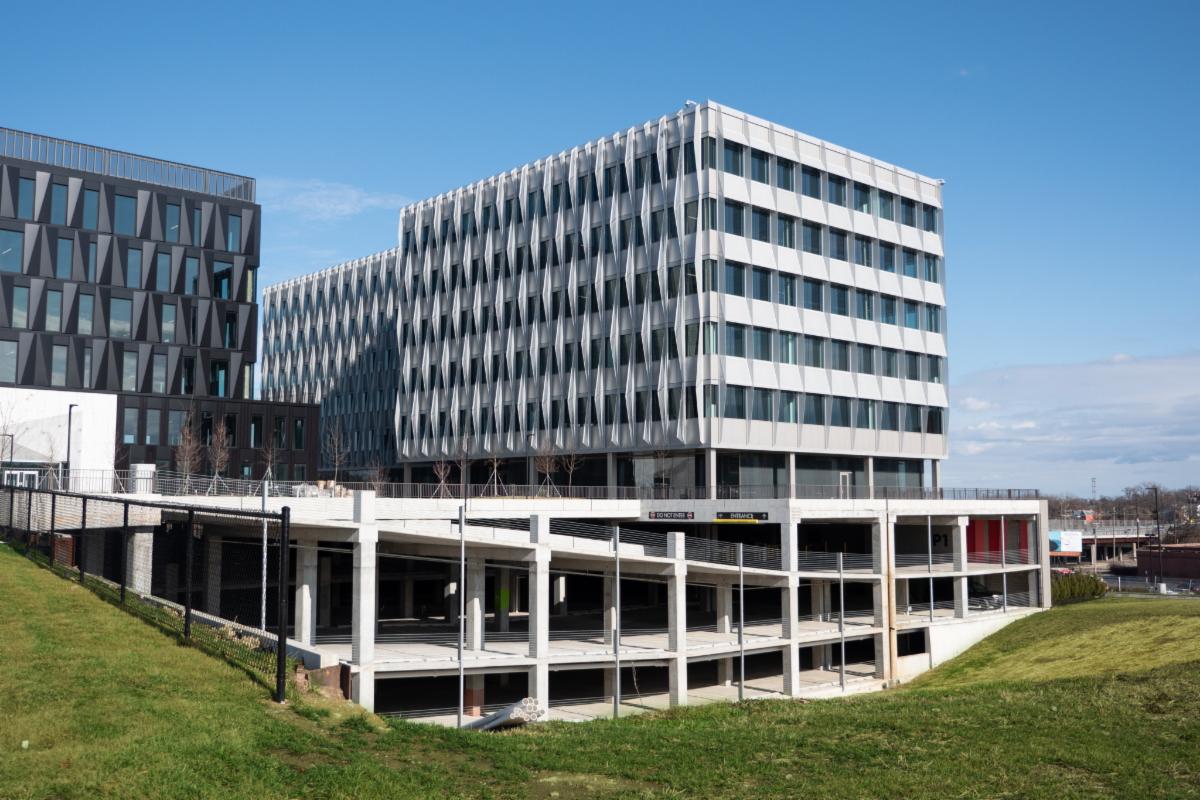
Digital Futures Grand Opening 2.0: Celebrating a Year of Solving Problems that Matter
Facts + figures.
The Office of Research is accelerating research at University of Cincinnati and economic growth in our region by connecting industry, government, and community leaders with the University of Cincinnati thought leaders and innovators. Together, we can positively impact the lives, environment, and the economy in our region and beyond. Some of our key research strengths are highlighted below.

Skin Science

Adolescence

Digital Humanities

Infectious Diseases

Medical Devices

Neuroscience

Smart Cities

Sustainability

Urban Futures

Active Awards
Active Award Funding
Active Externally Funded Researchers
FY23 Invention Disclosures
Events + Training
Online training, viral vectors.
Target Audience: Open to the public and UC researchers who plan to work with viral vectors
Research Office: Biosafety
Biosafety Cabinets Training
Target Audience: UC researchers who use biosafety cabinets as part of their research experiments
OSHA Bloodborne Pathogens (BBP)
Target Audience: Anyone working on projects involving human-derived material
Shipping of Biohazardous Materials
Target Audience: UC researchers who plan to ship biohazard materials
Introduction to Biosafety
Target Audience: Any researcher
Lab Hazards Awareness Training
Target Audience: Support personnel, students and new employees
Conflicts of Interest in Research
Target Audience: All faculty and staff who conduct research at UC
Research Office: Office of Research Security and Ethics
Export Compliance for Researchers
Target Audience: All personnel conducting restricted work
Research Office: Export Controls
FDA Regulated Research Activities Online Training
Target Audience: All principal investigators, co-principal investigators, and study coordinators engaged in FDA regulated research
Research Office: Human Research Protection Program
Funding Opportunities
Office of research funding, external funding, limited submission.
Cornell Chronicle
- Architecture & Design
- Arts & Humanities
- Business, Economics & Entrepreneurship
- Computing & Information Sciences
- Energy, Environment & Sustainability
- Food & Agriculture
- Global Reach
- Health, Nutrition & Medicine
- Law, Government & Public Policy
- Life Sciences & Veterinary Medicine
- Physical Sciences & Engineering
- Social & Behavioral Sciences
- Coronavirus
- News & Events
- Public Engagement
- New York City
- Photos of the Week
- Big Red Sports
- Freedom of Expression
- Student Life
- University Statements
- Around Cornell
- All Stories
- In the News
- Expert Quotes
- Cornellians
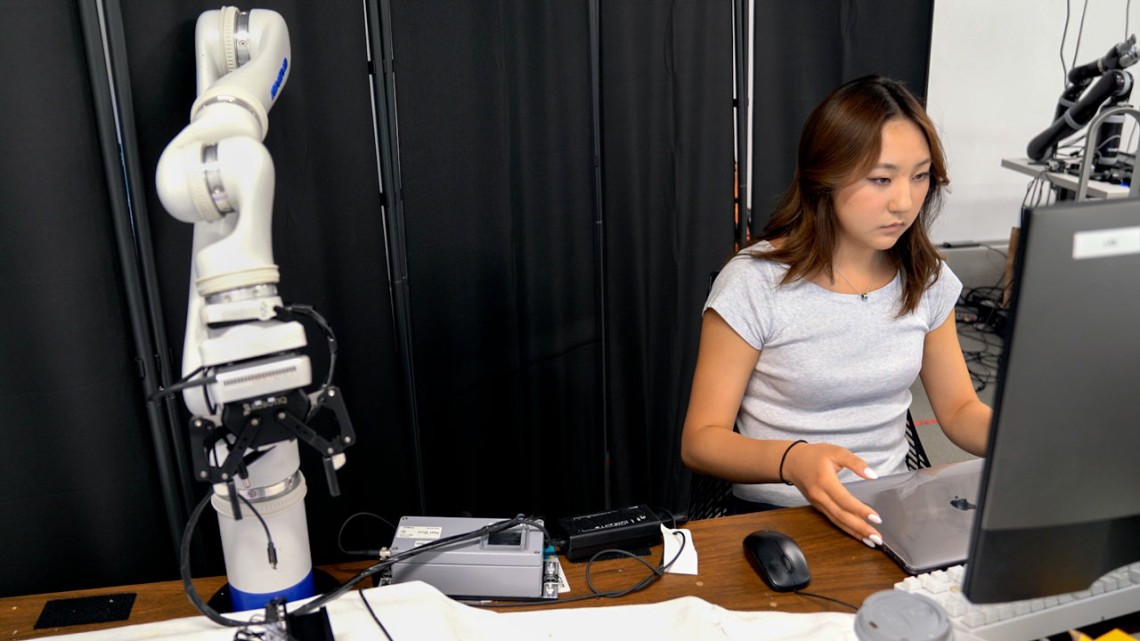
During this summer’s Bowers Undergraduate Research Experience, Joyce Yang ’27, a computer science major, worked with Cornell’s EmPRISE Lab to develop a robotic system to transfer a patient from a bed to a wheelchair.
Summer program gives undergraduates a taste of research life
By louis dipietro cornell ann s. bowers college of computing and information science..
Research takes time.
“On top of classes and extracurricular commitments, I often struggle to find enough time for research during the semester,” said James Kim ’25, a computer science and math major.
But this summer, thanks to the Bowers Undergraduate Research Experience (BURE) , Kim, along with 60 of his undergraduate peers from the Cornell Ann S. Bowers College of Computing and Information Science, can give research the time it requires. In the process, Kim is discovering a career path. Working alongside Amy Kuceyeski , adjunct associate professor of statistics and data science and professor of mathematics in radiology and of mathematics in neuroscience in the Feil Family Brain and Mind Research Institute at Weill Cornell Medicine, Kim uses machine learning models to analyze brain scans and predict the onset of various neurological disorders. He plans to pursue a doctoral degree in computer science, with a focus on artificial intelligence, neuroscience and health care.

Kabir Samsi ’26, a computer science major and music minor, spent his summer working in a Cornell lab as part of the Bowers Undergraduate Research Experience.
“What I was able to get done over two months during the semester, I got done in maybe a week or two here during the summer,” Kim said. “BURE has been extremely worthwhile. The mentorship and the support have been priceless.”
Hosted by the Cornell Bowers CIS and encompassing Cornell’s Ithaca campus and Cornell Tech in New York City, BURE is a 10-week summer program where Cornell undergraduates are paired with one of nearly 40 faculty mentors and their doctoral students to tackle a specific research project. BURE students work full time for an hourly wage or a research stipend. Open to all Cornell Bowers CIS undergraduates, the program is meant to give undergraduate students a preview of the open, free-form nature of research so that they can decide whether pursuing a doctoral degree is the right choice, said Adrian Sampson , associate professor of computer science and a BURE mentor.
“If students are at all considering a career in research, it does not make sense to immediately apply to a Ph.D. program without doing any,” said Sampson, who is mentoring six undergraduate students in his Computer Architecture and Programming Abstractions (CAPRA) lab this summer. “By the end of the summer, I hope students get a sense of whether this is something they want to do long term. Maybe they like research, or they don’t. There’s no shame in either direction.”
BURE student Joyce Yang ’27 is working with the EmPRISE Lab , directed by Tapomayukh Bhattacharjee , assistant professor of computer science, to develop a robotic system that can safely transfer a care recipient from a bed to a wheelchair. While there has been limited research on this topic, human transferring is one of caregivers’ most challenging daily tasks, making her work all the more meaningful, Yang said.
“With research, I think it’s fun that you never really know when you’re going to be done with a project, and that it can go as far as you’d like it to go,” said Yang, a computer science major. “There’s a possibility of discovering or inventing something that’s novel, and, especially with robotics, something that could truly have a positive impact in people’s lives.”
Along with research opportunities, BURE offers a series of weekly talks from mentors about life as a researcher, and regular social events throughout the summer. At BURE’s conclusion, participating students showcase their work during a research symposium.
BURE has given Kabir Samsi ’26 the time and experience to decide what he’d like to do after his undergraduate studies, he said.
“The experience has been fantastic,” said Samsi, a computer science major and music minor who is working in Sampson’s CAPRA Lab on a project related to packet scheduling, a model for improving the way computer systems handle flows of data. “I think it's hugely inspired me to want to continue a path of research.”
New this summer is BURE Next , run by the Cornell Bowers CIS’s Office of Diversity, Equity, Inclusion, and Belonging. It was created to encourage research opportunities for undergraduate students from underrepresented groups everywhere – not just at Cornell; anyone can apply. Four students are participating in BURE Next this summer.
BURE is offered every summer, and Cornell Bowers CIS students can apply via the college’s website .
Louis DiPietro is a writer for the Cornell Ann S. Bowers College of Computing and Information Science.
Media Contact
Becka bowyer.
Get Cornell news delivered right to your inbox.
You might also like

Gallery Heading
Suggestions or feedback?
MIT News | Massachusetts Institute of Technology
- Machine learning
- Sustainability
- Black holes
- Classes and programs
Departments
- Aeronautics and Astronautics
- Brain and Cognitive Sciences
- Architecture
- Political Science
- Mechanical Engineering
Centers, Labs, & Programs
- Abdul Latif Jameel Poverty Action Lab (J-PAL)
- Picower Institute for Learning and Memory
- Lincoln Laboratory
- School of Architecture + Planning
- School of Engineering
- School of Humanities, Arts, and Social Sciences
- Sloan School of Management
- School of Science
- MIT Schwarzman College of Computing
Lincoln Laboratory and National Strategic Research Institute launch student research program to tackle biothreats to national security
Press contact :.
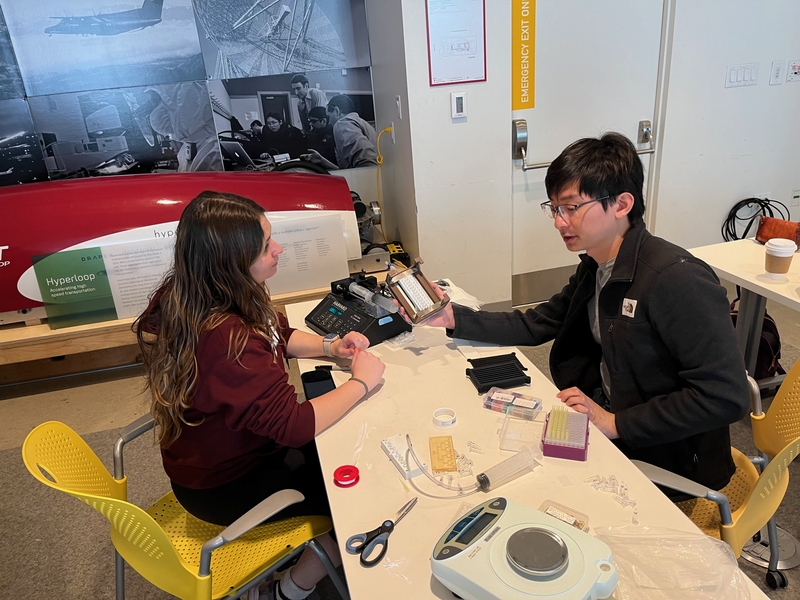
Previous image Next image
The following announcement was released jointly by MIT Lincoln Laboratory and the National Strategic Research Institute.
MIT Lincoln Laboratory and the National Strategic Research Institute (NSRI) at the University of Nebraska (NU), a university-affiliated research center designated by the U.S. Department of Defense (DoD), have established a joint student research program.
The goal is to bring together the scientific expertise, cutting-edge capabilities, and student capacity of NU and MIT for critical issues within global health and agricultural security, aiming to foster solutions to detect and neutralize emerging biological threats.
"We are excited to combine forces with NSRI to develop critical biotechnologies that will enhance national security," says Catherine Cabrera, who leads Lincoln Laboratory's Biological and Chemical Technologies Group. "This partnership underscores our shared commitment to safeguarding America through scientific leadership."
"In an era of rapidly evolving dangers, we must stay ahead of the curve through continuous innovation," says David Roberts , the NSRI research director for special programs. "This partnership harnesses a unique combination of strengths from two leading academic institutions and two research institutes to create new paradigms in biological defense."
With funding from a DoD agency, the collaborators conducted a pilot of the program embedded within the MIT Engineering Systems Design and Development II course . The students’ challenge was to develop methods to rapidly screen for novel biosynthetic capabilities. Currently, such methods are limited by the lack of standardized, high-throughput devices that can support the culture of traditionally “uncultivable” microorganisms, which severely limits the cell diversity that could be probed for bioprospecting or biomanufacturing applications.
Led by Todd Thorsen , a technical staff member in the Biological and Chemical Technologies Group at Lincoln Laboratory, MIT students created the project, "Bioprospecting Experimentation Apparatus with Variable Environmental Regulation," which focused on developing simple high-throughput tools with integrated environmental control systems to expand the environmental testing envelope.
"This program, which emphasizes both engineering design and prototyping, challenges students to take what they learned in the classroom in their past undergraduate and graduate studies, and apply it to a real-world problem," Thorsen says. "For many students, the hands-on nature of this course is an exciting opportunity to test their abilities to prioritize what is important in developing products that are both functional and easy to use. What I found most impressive was the students’ ability to apply their collective knowledge to the design and prototyping of the biomedical devices, emphasizing their diverse backgrounds in areas like fluid mechanicals, controls, and solid mechanics."
In total, 12 mechanical engineering students contributed to the program, producing and validating a gas gradient manifold prototype and a droplet-dispensing manifold that has the potential to generate arbitrary pH gradients in industry-standard 96-well plates used for biomedical research. These devices will greatly simplify and accelerate the microculture of complex mixtures of organisms, like bacteria populations, where the growth conditions are unknown, allowing the end user to use the manifolds to dial in the optimal environmental parameters without the need for expensive, bulky hardware like the anaerobic chambers typically used for microbiology research.
"This class was my first experience with microfluidics and biotech, and thanks to our sponsors, I gained the confidence to pursue a career path in biotech," says Rachael Rosco, an MIT mechanical engineering graduate student. "The project itself was meaningful, and I know that our work will hopefully one day make an impact. Who knows, maybe one day it will lead to cultivating extremophile bacteria on a foreign planet!"
The collaboration will continue to seek DoD research funding to create workforce development opportunities for top scientific talent and introduce students to long-standing DoD challenges. Projects will take place nationwide at several NSRI, NU, Lincoln Laboratory, and MIT facilities.
Share this news article on:
Related links.
- Biological and Chemical Technologies Group
- MIT Lincoln Laboratory
- National Strategic Research Institute
Related Topics
- Education, teaching, academics
- Mechanical engineering
- Bioengineering and biotechnology
- Security studies and military
- Collaboration
- STEM education
- Synthetic biology
- Department of Defense (DoD)
Related Articles
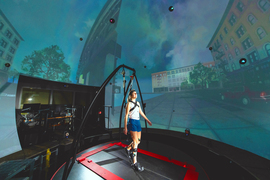
Lincoln Laboratory establishes Biotechnology and Human Systems Division
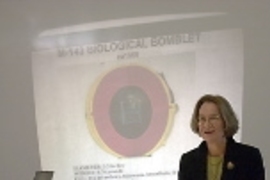
Biological weapons are overrated as a military threat, expert says
Lincoln lab exhibit explores the technology of national security.
Previous item Next item
More MIT News
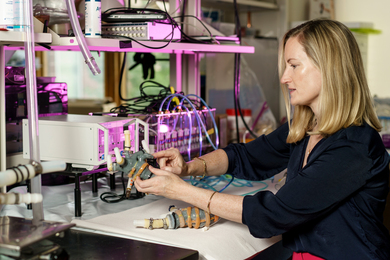
Engineering and matters of the heart
Read full story →

Creating connection with science communication

AI assistant monitors teamwork to promote effective collaboration

MIT study explains why laws are written in an incomprehensible style
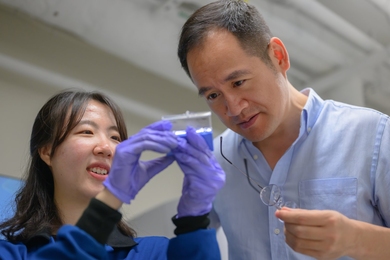
More durable metals for fusion power reactors

When the lights turned on in the universe
- More news on MIT News homepage →
Massachusetts Institute of Technology 77 Massachusetts Avenue, Cambridge, MA, USA
- Map (opens in new window)
- Events (opens in new window)
- People (opens in new window)
- Careers (opens in new window)
- Accessibility
- Social Media Hub
- MIT on Facebook
- MIT on YouTube
- MIT on Instagram
Notification: View the latest site access restrictions, updates, and resources related to the coronavirus (COVID-19) »
Kestrel Supercomputer Ready To Energize Renewable Energy Research
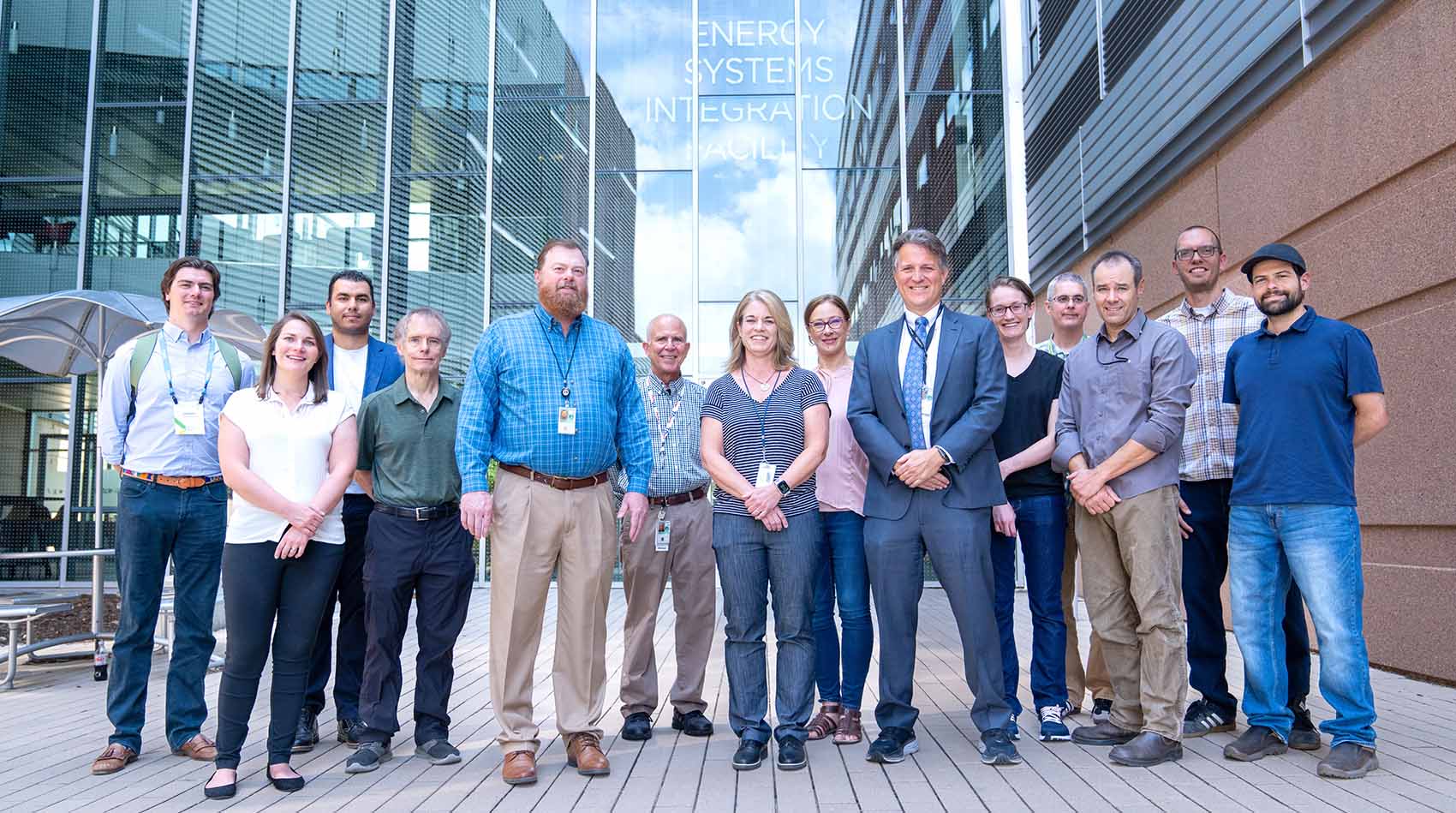
After more than two years of hard work, the Kestrel supercomputer completed its full buildout to reach 44 petaflops of computing power focused on renewable energy and energy efficiency research.
Built by Hewlett Packard Enterprise, the high-performance computing system boasts more than five times the computing power of the National Renewable Energy Laboratory's (NREL's) previous supercomputer, Eagle, and will supercharge the U.S. Department of Energy (DOE) Office of Energy Efficiency and Renewable Energy (EERE).
With this summer's completion of the installation, Kestrel now adds 132 graphics processing unit (GPU) nodes—each hosting four NVIDIA H100 GPU processors—to the 2,314 existing central processing unit (CPU) nodes with two Intel Sapphire Rapids processors. The new GPU nodes are already in use by more than 60 projects, elevating the work at EERE to new heights by enabling emerging artificial intelligence and machine learning workflows.
"The new Kestrel GPU nodes are proving to be extremely powerful—our project has developed algorithms that showcase Kestrel's impressive GPU acceleration for materials and chemistry modeling," said NREL's Derek Vigil-Fowler, principal investigator on the Beyond-DFT Electrochemistry with Accelerated and Solvated Techniques (BEAST) project, funded by DOE's Office of Science. "We are leveraging the GPUs on Kestrel for high-fidelity simulation of electrocatalytic systems, with the aim of designing better catalysts for water electrolysis, fuel cells, and carbon dioxide reduction. The ability to simulate complex models of catalytic systems with high fidelity is invaluable to understanding factors that determine electrocatalytic performance, and Kestrel GPUs have demonstrated excellent efficiency and scaling for these simulations."
Text version for Kestrel Supercomputer: Why GPUs Matter
The work to install Kestrel in NREL's Energy Systems Integration Facility user facility data center kicked off with the arrival of the first phase of equipment—including 2,314 CPU nodes and a 95-petabyte parallel storage system—in March 2023. The CPU phase of Kestrel was installed last summer and was made available to early users, and then Kestrel opened for all projects for the start of the 2024 fiscal year. In November 2023, the CPU phase of Kestrel landed at #67 on the 62 nd edition of the TOP500 , an industry-standard list of the 500 most powerful computers in the world, showcasing 14.3 petaflops of performance from the CPU capability alone on Kestrel.

Excitement swelled as the remainder of the Kestrel system arrived in February 2024: GPU nodes featuring NVIDIA's latest H100 GPUs. Testing and validation of the new GPU nodes, and their integration into the full Kestrel system, was completed in May, when early users were invited to test their codes and help get the system ready for all users. Kestrel's GPU nodes are now released to all Kestrel users to accelerate research critical to the energy transition.
Text version for Kestrel Supercomputer: Taking Flight at NREL
"With Kestrel, researchers have access to advanced computing capabilities to do high-quality research at the pace and scale necessary to enable the energy transition," said NREL's Kristin Munch, laboratory program manager for advanced computing and Kestrel project manager. "We've been building to this moment for more than two years with a tremendous team working diligently to bring this impressive system online for EERE researchers."
Now that Kestrel is fully complete, researchers are already plugging in and using Kestrel's power to accelerate energy research, driving advancements in energy efficiency, sustainable transportation, renewable power, and energy systems integration. The FY 2023 Advanced Computing Annual Report details how high-performance computing is advancing clean energy research and scientific collaboration.
"We are super excited to have the full capabilities of Kestrel available to the research community," said NREL's Aaron Andersen, advanced computing operations group manager. "Kestrel's CPU nodes utilize 100% direct liquid cooling for all components. From an efficiency standpoint, Kestrel has more than two times the efficiency of our previous supercomputer, Eagle, providing 10.4 gigaflops per watt versus Eagle at 4.7 gigaflops per watt. Kestrel continues NREL's leadership in efficient computing."
Learn more about Kestrel and its capabilities.

IMAGES
COMMENTS
Research highlights. The RNA Nanotherapeutics Lab is driving discoveries to improve early detection and treatment for liver cancer and biliary cancer. The Spatial Biology Core offers investigators tools and collaboration for conducting basic cellular research. The Neuroregeneration and Neurorehabilitation Lab advances plasticity, regenerative ...
From A (nalytical and stable isotopes) to Z (ebrafish phenotyping), research at Yale combines serious inquiry, deep expertise, and state-of-the-art technology. About Research at Yale. Yale's research cores enable scientists across campus to interact, collaborate, and develop new applications that advance the university's scientific mission.
Research. With expenditures in excess of $1 billion, research is central to U-M's mission and permeates all 19 schools and colleges. U-M is a strong advocate of promoting collaboration and interdisciplinary research initiatives that involve faculty and students from across campus. U-M researchers have demonstrated organic solar cells that can ...
The Office of Undergraduate Research and Fellowships helps students navigate the research opportunities available here on campus, in the Cambridge area, and around the world. As a college within a research university, Harvard undergraduates have access to unparalleled research opportunities. Learn about research at Harvard.
ASPIRE grants : Promote independent research projects among undergrads in the School of Arts and Sciences; awards range from $500 to $4,500 per academic year. Learn more: Hopkins Office of Undergraduate Research. Student research opportunities at the School of Engineering. Student research opportunities at the School of Arts and Sciences.
Access 160+ million publications and connect with 25+ million researchers. Join for free and gain visibility by uploading your research.
Research is the careful consideration of study regarding a particular concern or research problem using scientific methods. According to the American sociologist Earl Robert Babbie, "research is a systematic inquiry to describe, explain, predict, and control the observed phenomenon. It involves inductive and deductive methods.".
Research flourishes in our 30 departments across five schools and one college, as well as in dozens of centers, labs, and programs that convene experts across disciplines to explore new intellectual frontiers and solve important societal problems. Our on-campus research capabilities are enhanced through the work of MIT Lincoln Laboratory, the Woods Hole Oceanographic Institution, active ...
The Office of Research maintains the Workday Finance & Research webpage, which includes information, instructions, and resources to help you navigate the transition to Workday Finance. This one-stop resource is updated with the latest information and links as they are released. Visit Web Page.
We support the broader research community through our Faculty Engagement and Student Support programs, and by providing Research Datasets and Tools & Resources Learn More. Work at Google Google is a fantastic place to do research. The ability to work on really interesting problems, with excellent colleagues (whose expertise is often very ...
Research. Brown is a research university that regards the creation of knowledge as one of its fundamental missions. Our faculty and students work at the cutting edge of research in their fields and collaborate with colleagues across disciplines and around the world to address society's biggest challenges.
Research is the deliberate, purposeful, and systematic gathering of data, information, facts, and/or opinions for the advancement of personal, societal, or overall human knowledge. Based on this definition, we all do research all the time. Most of this research is casual research. Asking friends what they think of different restaurants, looking ...
Strength in research helps to define a university's "brand" in the national and international marketplace, impacting everything from student recruitment, to faculty retention, to attracting ...
Advancing research into the historical, philosophical, literary, artistic, and cultural dimensions of the human experience. Stanford Humanities Center. Stanford Bio-X. Biomedical and life science researchers, clinicians, engineers, physicists and computational scientists come together to unlock the secrets of the human body.
Research at UF plays a significant role in advancing our fundamental understanding of the universe, generating creative breakthroughs that lead to technologies with positive benefit, creating opportunities for economic growth in the state, and changing the trajectory of young people through education. UF Research is committed to facilitating ...
Research & Innovation. With more than $1.37 billion in annual R&D expenditures, Penn is one of the nation's top research universities, not only generating important new knowledge in the fields of medicine, technology, business, science, and beyond, but applying this knowledge to improve the lives of individuals and communities at home and around the world.
Arizona Research, Innovation & Impact. The Office for Research, Innovation and Impact advances the world-class research enterprise at the University of Arizona, a top-ranking public institution with over $955M in annual research expenditures. Our bold, forward-thinking innovators are focused on transformational discoveries and inventions that ...
Research shows our bodies go through rapid changes in our 40s and our 60s These metabolic shifts may be causing significant differences in cardiovascular health and immune function. Get more news
Learn more about clinical trials at Penn. As one of the world's top research institutions, our entire health system is built on groundbreaking discoveries. But there's more to it than that. It's personal to us at Penn Medicine, because our work is inspired by real people, their stories and even their DNA. We never forget that what we do ...
Penn State Research brings solutions and innovations which result in visible changes in our communities, global health, economic wellness, humanitarian efforts and worldwide positioning against our most difficult issues, over many years to come. It's time to understand the true impact of our research enterprise.".
Research is defined as a meticulous and systematic inquiry process designed to explore and unravel specific subjects or issues with precision. This methodical approach encompasses the thorough collection, rigorous analysis, and insightful interpretation of information, aiming to delve deep into the nuances of a chosen field of study.
ResearchMatch helps you find a clinical trial or research study near you, or across the country, by matching you with researchers from leading medical research institutions. Whether you are a healthy volunteer or have a health condition, ResearchMatch connects you to research opportunities so you can make a difference and advance scientific discoveries by participating in research studies ...
Research methods are specific procedures for collecting and analyzing data. Developing your research methods is an integral part of your research design. When planning your methods, there are two key decisions you will make. First, decide how you will collect data. Your methods depend on what type of data you need to answer your research question:
Since accelerated aging in women could have been attributed to menopause (which is typically between ages 45 and 55), the researchers performed analysis on separate male and female datasets.
His research focuses on digital marketing, aesthetics and design, and social influence in consumption contexts. Michelle Daniels is an assistant professor of marketing at the University of Alabama.
Research 2030: UC's 10-yr Strategic Plan for Research. The University of Cincinnati is the leading R1 urban university in our region with unrivaled talent solving problems that matter. We are rigorously pursuing the next culture of research and actively transforming society through game-changing knowledge and disruptive discoveries. View Plan
At the heart of any fusion system is a burning plasma, an ultrahot — at least 100 million degrees — ionized gas of atoms fusing together. Over the past three decades, computational models of ...
Along with research opportunities, BURE offers a series of weekly talks from mentors about life as a researcher, and regular social events throughout the summer. At BURE's conclusion, participating students showcase their work during a research symposium.
The following announcement was released jointly by MIT Lincoln Laboratory and the National Strategic Research Institute. MIT Lincoln Laboratory and the National Strategic Research Institute (NSRI) at the University of Nebraska (NU), a university-affiliated research center designated by the U.S. Department of Defense (DoD), have established a joint student research program.
"With Kestrel, researchers have access to advanced computing capabilities to do high-quality research at the pace and scale necessary to enable the energy transition," said NREL's Kristin Munch, laboratory program manager for advanced computing and Kestrel project manager. "We've been building to this moment for more than two years with a ...